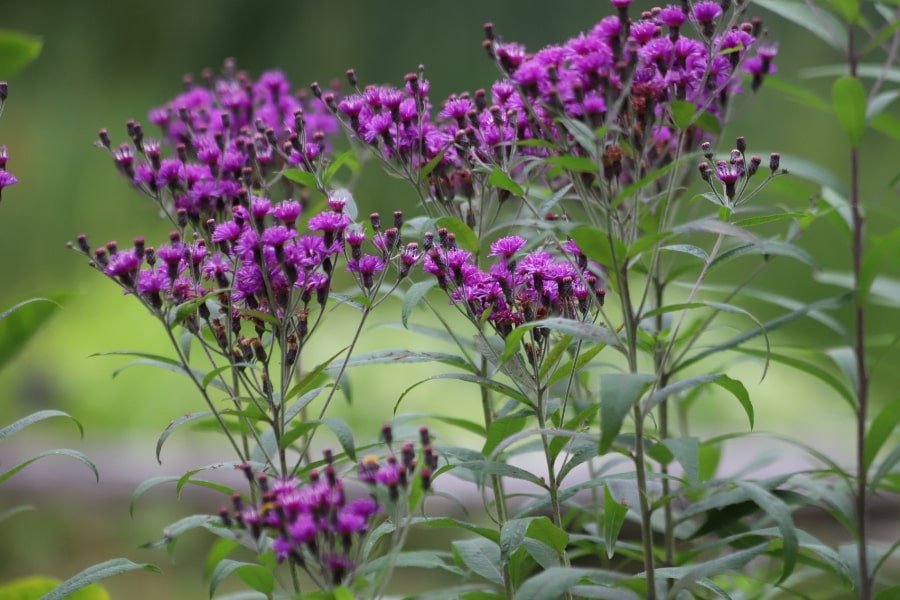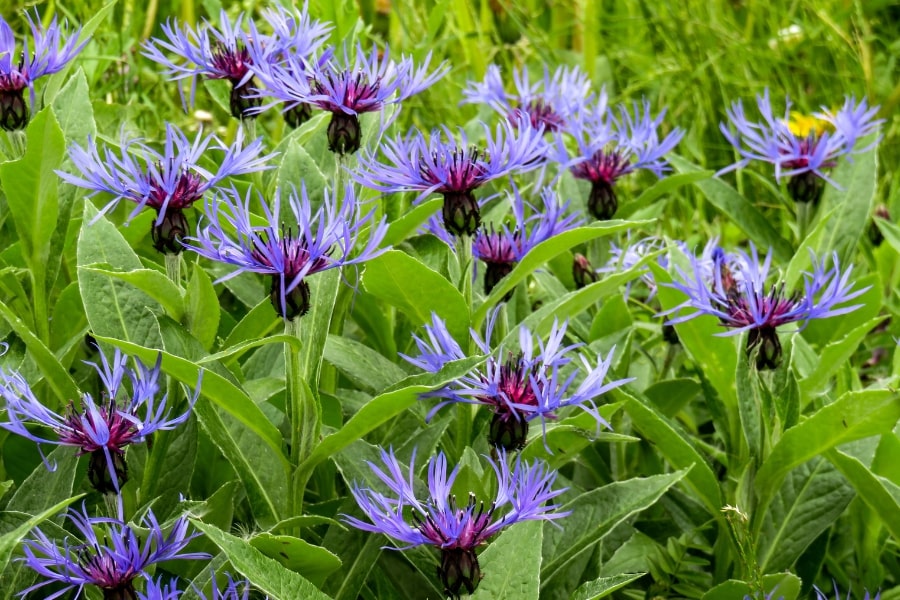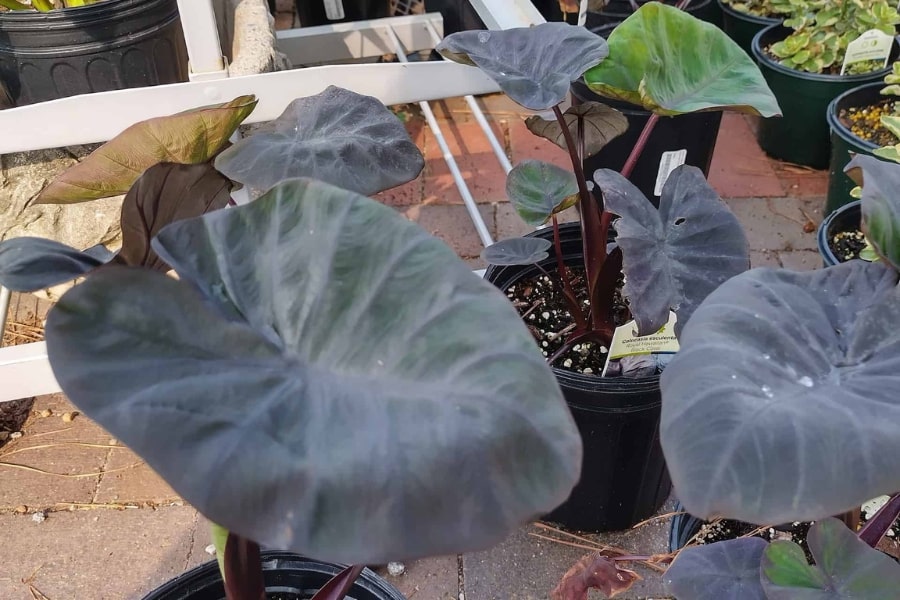At Martin Garden Center, we grow many of the gallon perennials that we know gardeners want but can’t find regularly. The most popular of these include:
- Astilbe – We sell about 100-200 tubers each year and 200-300 varieties in 1-gallon containers, averaging 8-15 varieties per year.
- Dahlia – We sell approximately 400 tubers each year and any that are left over are sold as 1-gallon plants. We sell 8-10 varieties of patio dahlias that don’t require staking and 8 or so dinnerplate dahlia that do require staking.
- Daylilies – We carry 10-20 varieties in 1-gallon pots and sell between 300-500 each year.
- Ferns – We sell about 1000 perennial ferns in various sizes from 4″, to 1-3 gallons.
- Hosta – We sell 200 or so tubers each year and between 500-1000 hosta in pots, usually 1-gallon. We carry 30+ varieties at any given time.
- Peony – We sell 200 or more tubers each year and 500 or so in 2-3 gallon pots.
Our Selection of Gallon Perennials
While not an exhaustive list, the following are the Gallon Perennials that can be found, in season, at Martin Garden Center:
Acanthus (Bears Britches)
This awesome herbaceous shade perennial sends a spike up with a purple calyx that erupts with white flowers on spiny, gray-green foliage. Wow. We purchase Acanthus from our vendors in 1-2 gallon containers. It is usually available in the early spring from late February through April, before we sell out. We do not grow this plant and are totally reliant on our vendors. Some of the varieties that we’ve seen in the past include the non-hybrid Bears Britches and Summer Beauty which promises resilience in the summer heat.
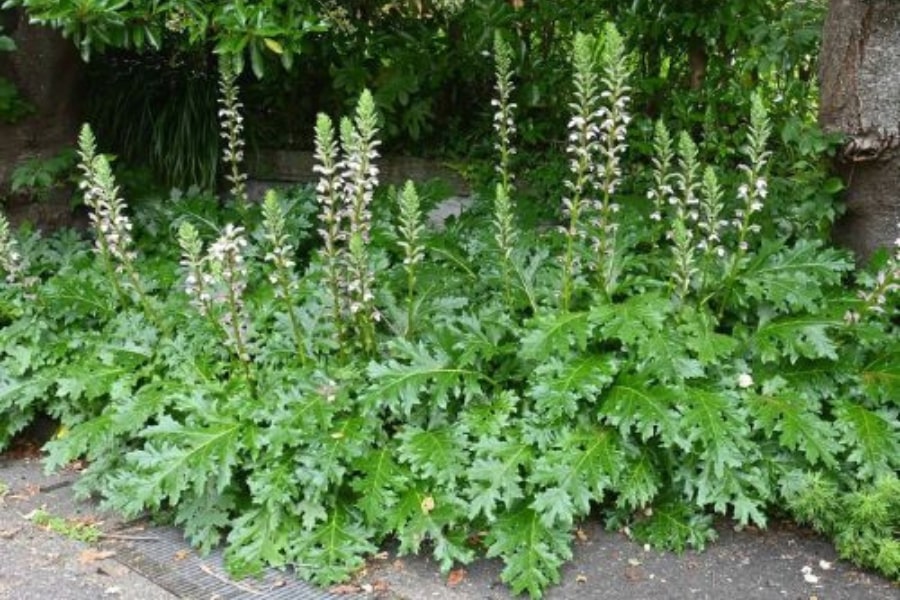
Agapanthus (Lily of the Nile)
Agapanthus or Lily of the Nile (less commonly known as the African Lily) provides umbels of blue, white, or lavender tubular blooms on slender stems. The blooms are prized, often appearing mid-summer, but short lived. Planted in mass and abloom, they are stunning. They also can be used in a mixed where their attractive lily leaves provide depth while waiting for the blooms. At Martin Garden Center, we do not grow these plants but rely on vendors to provide. Popular varieties that we have on occasion include Storm Cloud, Peter Pan, White Superior and Queen Mum. Other varieties may or may not be available include the Ever series (Amethyst & Midnight) and the Straight A series including Shona, Blue Bayou, Barley Blue and Blue Flare. These plants are semi-evergreen in the Upstate.

Alcea (Hollyhock)
Just because it’s beautiful. That’s why we are trying to grow Hollyhock, a plant susceptible to deadly rust. With our years of success growing Malva (also susceptible to rust), we’re trying Hollyhock Fiesta Time in 2024. Of course, it will be grown in an enclosed and protected environment. And, when we sell it, there will be “Buyer Beware” signs posted everywhere. However, if our customers have no sources of rust, which is everywhere at Martin Garden Center due to our pine trees that naturally carry rust, this plant may well be a game changer. Or, we could lose the entire crop. But, it’s a chance we’re willing to take to offer our customers up this beauty, Hollyhock This is an herbaceous perennial.
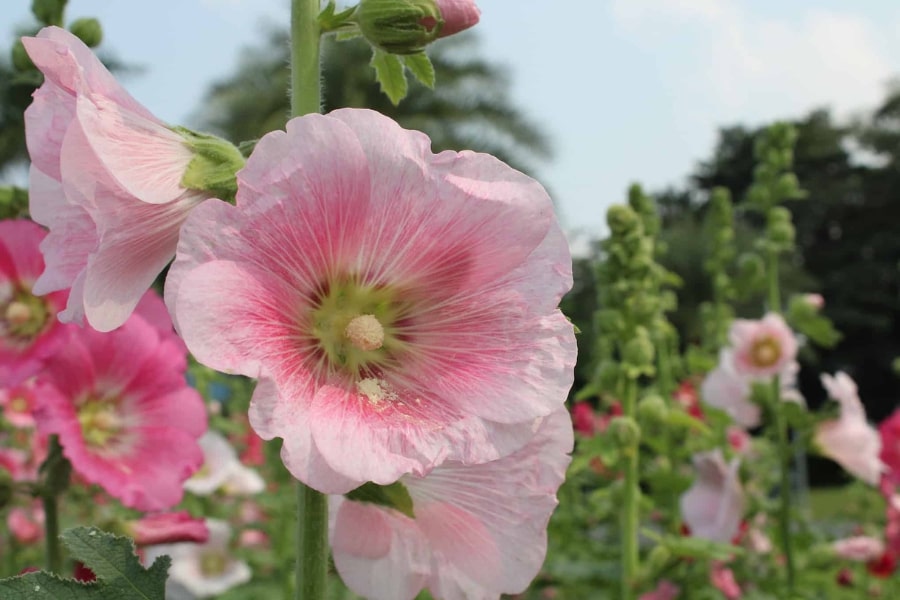
Allium (Ornamental Onion)
Every garden needs allium, which is related to the onion family. This late spring bulb bloomer with its round poofs of purple/lavender/blue, pink and occasionally white, is a showstopper. There are orange and yellow bloomers as well. We typically carry bulbs in the fall of Gladiator, Globemaster and Millenium. In 2024, we are growing Millenium, Little Sapphire and Windy City in 6″ or gallon pots in the spring.
Did we mention that it is in the Onion family, and thus exhibits pest repellant properties particularly for thrip? Yes, Allium is a definite in the garden. We usually see these plants in the spring right before they bloom because blooming plants sell. Though we foolishly have brought them in late summer, where they sit till the next season because blooming plants sell. In sum, expect to see them only in the spring through early May, until they sell out, or look for the bulbs in fall, starting late August.
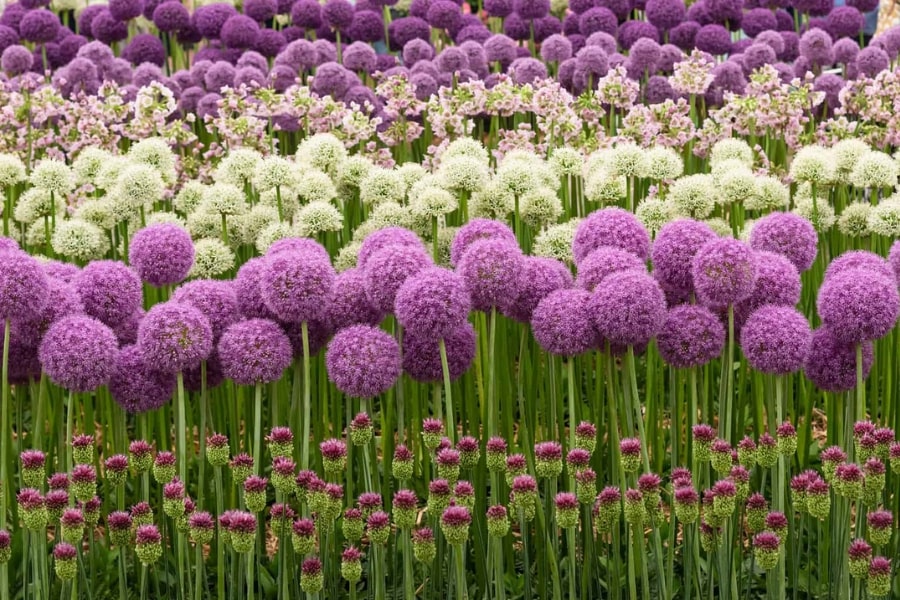
Amsonia (Blue Star)
We love Amsonia, particularly Storm Cloud and Blue Ice Amsonia, not so much Arkansas Amsonia (also called Amsonia hubrichti). Amsonia is a Native plant, and easy to grow. In the Upstate, it prefers afternoon shade but can tolerate full sun, though the foliage gets a little ratty.
The blue flowers of Amsonia steal the show (hence its common name Blue Star). After flowering in the spring, if you cut back the stems to 6-8 inches, the foliage grows in more fully and provides a great backdrop for your later bloomers. Amsonia is a herbaceous perennial, but before it dies back, the foliage color changes. Amsonia hubrichti particularly shines at this time, turning bright gold. In 2024, we are not growing Amsonia because we were able to purchase it through other vendors last year. We plan to again use our vendors to enable us to offer this plant again in the early spring when it flowers (greenhouse grown). In the wild, it flowers early summer. Amsonia is an herbaceous perennial in the Upstate.
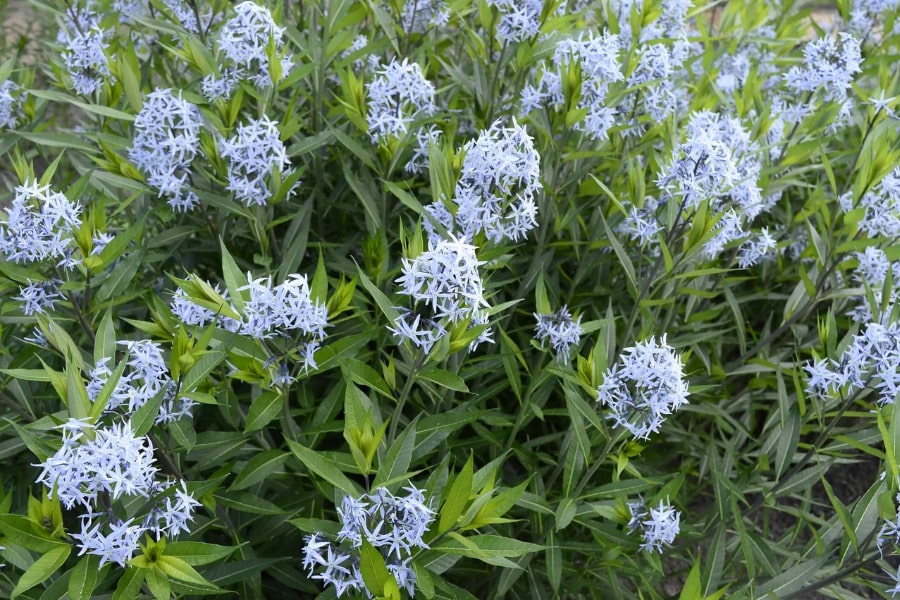
Anemone
This is not the groundcover anemone canadensis that blooms in early spring but rather the upright Japanese Anemone such as Honorine Jobert (white) and Lady Diana (pink) which flower in the fall. It is agonizing waiting for them to flower. Oh, but when the flowers come, they are well worth the wait. We grow the above listed Japanese Anemones nearly every year, but we can’t seem to keep them in stock as the knowing customer scoops them up before they bloom. Let us advise … buy them if you see them. They will be in our perennial shade section and is an herbaceous perennial.

Aralia (Sun King)
Sun King Aralia is stunning. Its chartreuse foliage makes for a gorgeous backdrop in shade or part-sun gardens. It grows to a large 3X3, herbaceous bush in just 3 years, so plan for its growth in your garden. We grow it every other year and we have a new crop coming in 2024. We grow it in 6″ containers but move it up to 2-gallon containers within the season. Cost conscious consumers should try to buy it earlier in the season for the best price. It should be available late April.
Sun King Aralia, like most Aralia, is a mite magnet. Watch your foliage for signs of mites and use Bonide’s Neem Oil as an organic solution. You will need to treat twice to safely eradicate the problem. This plant is an herbaceous perennial.
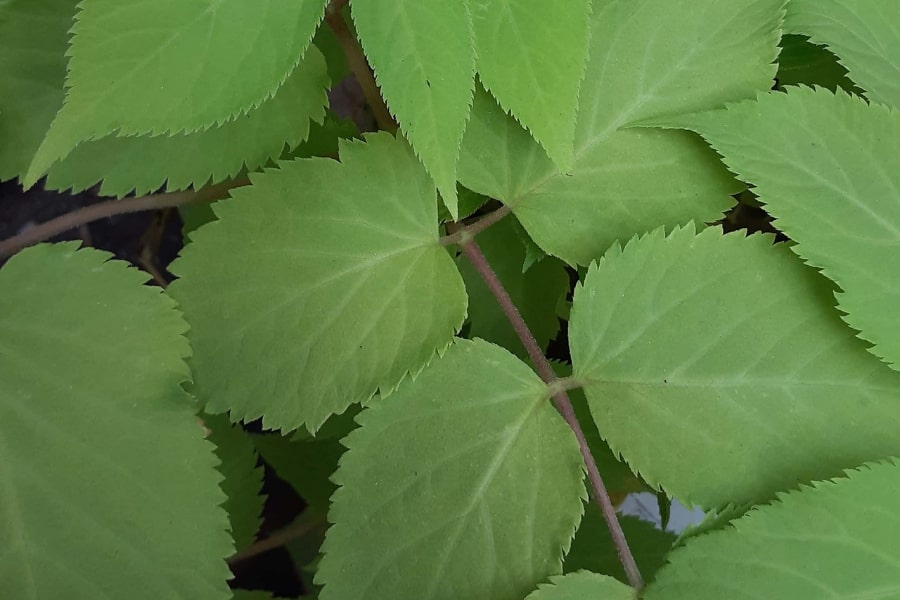
Aruncus (Goats Beard)
We can guarantee one thing about Aruncus … it is very hardy through drought, neglect, and poor soil. This shade loving perennial lives in our lower parking lot and comes back every year (it is herbaceous and thus dies to the ground at first frost). In the late spring, it sends up white plumes above fancy foliage. This 2024 year, we are growing Chantilly Lace. Do not believe any tag telling you Goats Beard can take full sun or that it requires moist soil because it does not. It is a shade-loving herbaceous perennial in the Upstate that survives poor soil and drought, so the only way you will kill it is if you pamper it and overwater it and/or put it in the full sun.
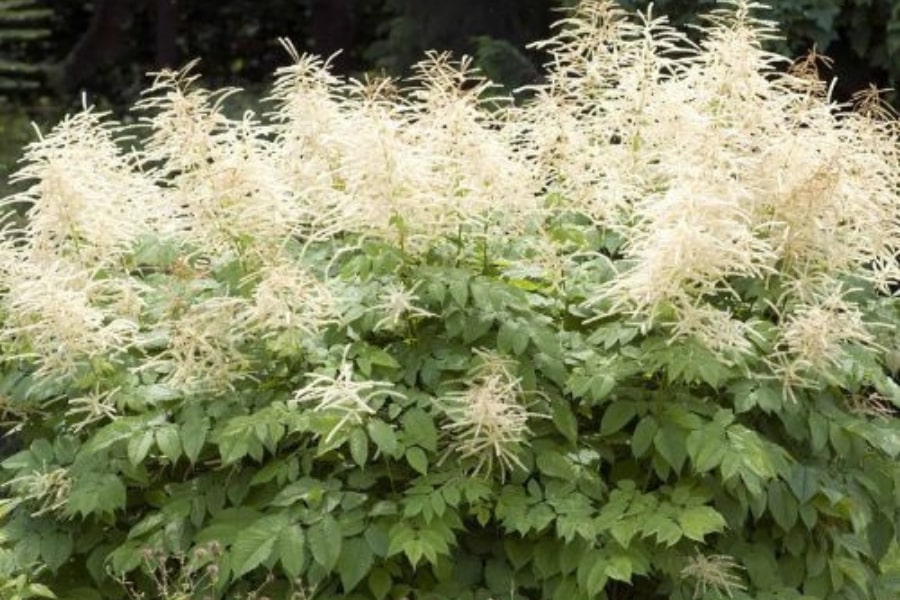
Astilbe
What shade garden is complete without Astilbe? Plumes of either white, red, purple and all the lavender, pink and peach tones in between. See our Astilbe page for more information about the varieties commonly found at Martin Garden Center. We sponsor an online tuber sale each year in February/March. You must be on our mailing list to receive information about the sale.
We sell about 100-200 tubers each year and 200-300 plants in 1-gallon containers, with 8-15 varieties. We don’t have all the varieties stocked all the time, but we do try to have all of the colors, for the most part. There was a time period when we couldn’t land a white variety to save our lives, but we have plenty of white for 2024. This plant is an herbaceous perennial.
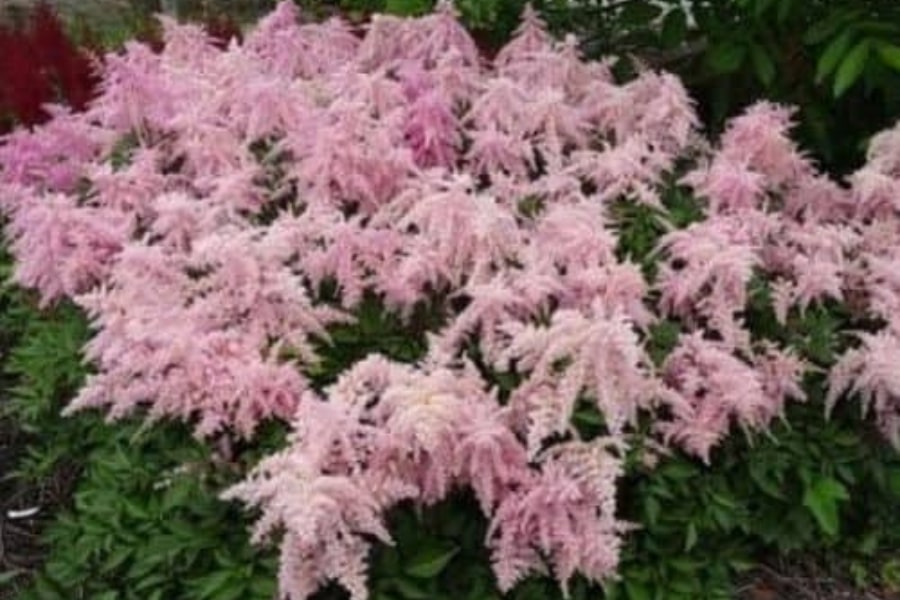
Baptisia (False Indigo)
Tall stalks with raceme pea-shaped flowers in bright blues to oranges to creams and pinks. And yellow. Very hardy, multiplies in place and long lasting. Extremely drought resistant when established. Blooms begin in mid-April and last approximately one month. Two of the most popular varieties are Proven Winner Pink Lemonade and Proven Winner Sparkling Sapphires which we have grown before and will see in early spring 2024. Adding to this, we are bringing in the Proven Winner Pink Truffles in 2024. This trifecta, along with several other gorgeous varieties such as American Goldfinch and the original Baptisia australis, will make a wonderful spring offering indeed.
Baptisia is also a host plant for several swallowtail butterfly larvae. You may see webbing in the late summer/early fall on these plants. It is a good thing. If caterpillars appear, let them eat in peace. Baptisia’s foliage will feed their bellies and the roots will remain intact, so that Baptisia will come back gangbusters next year. We sell about 75-100 Baptisia each year and they are usually sold out in mid-March to early April during their blooming cycle. This plant is an herbaceous perennial.’
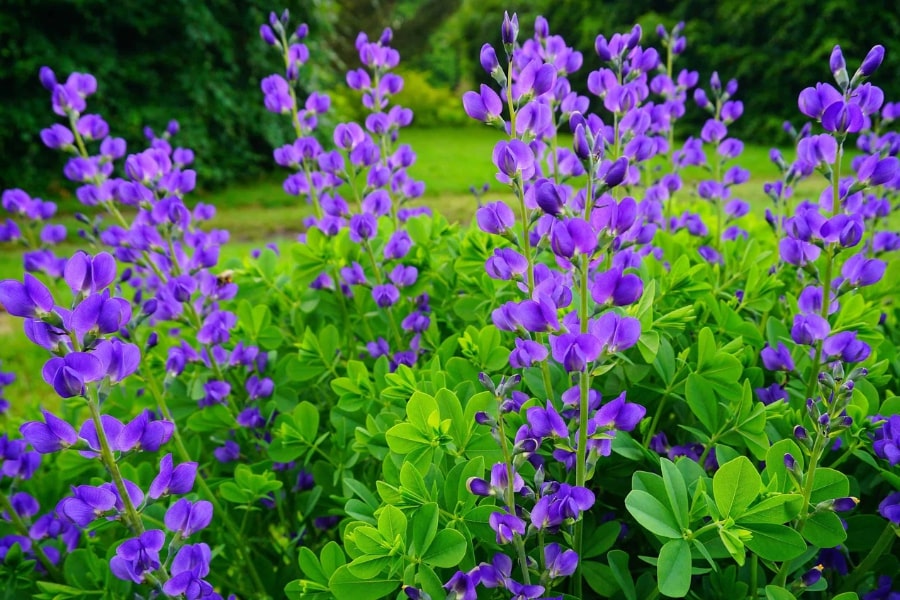
Begonia grandis (Hardy Begonia)
We don’t carry a lot of Hardy Begonia because its blooms are put to shame by the Dragon Wing Begonia. But, that being said, it is a perennial Begonia and thus we will have 1-gallon containers from time to time as offered through our single vendor who grows it. Hardy Begonia is perfect for a shady naturalized area that remains moist. It is incumbent upon the gardener to keep it moist as Hardy Begonia does not suffer drought well.
Note that several Martin Garden Center employees are hungering for this year’s crop to come available, probably late April. Hook up with our social media because we will announce its arrival. This plant is an herbaceous perennial.
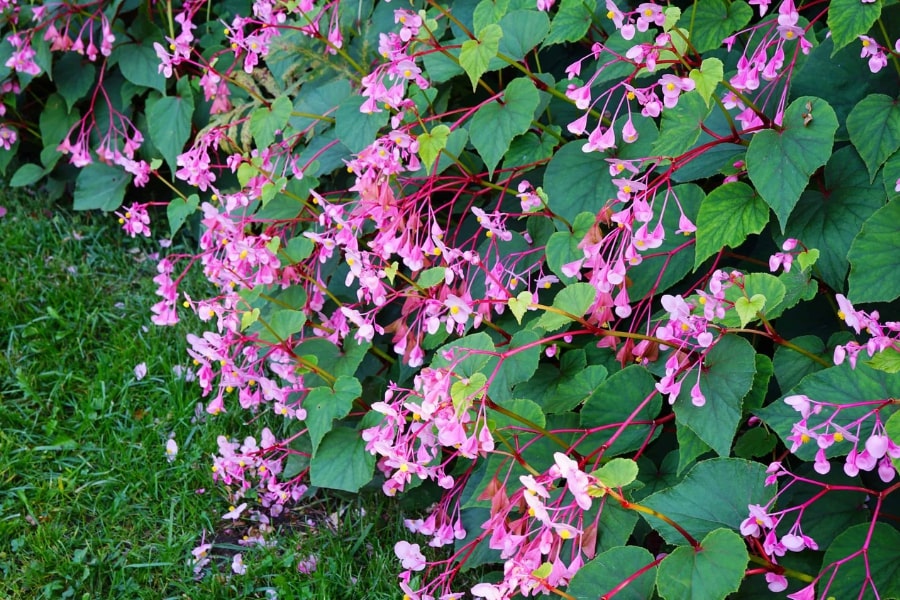
Bergenia
Bergenia is a part shade plant that provides hardy semi-evergreen heart shaped leaves as a base, almost groundcover, sending up adorable pink flowers in the early spring. In 2024, we are growing the Miss Piggy variety of Bergenia in 6″ pots. Bergenia is a specialty plant that gardeners search for because nobody grows it. So, if you are lucky enough to find a container available, ignore any tag that says it works well in the sun, because it does not. This is a part shade to full shade plant that enjoys a well-drained humic soil.
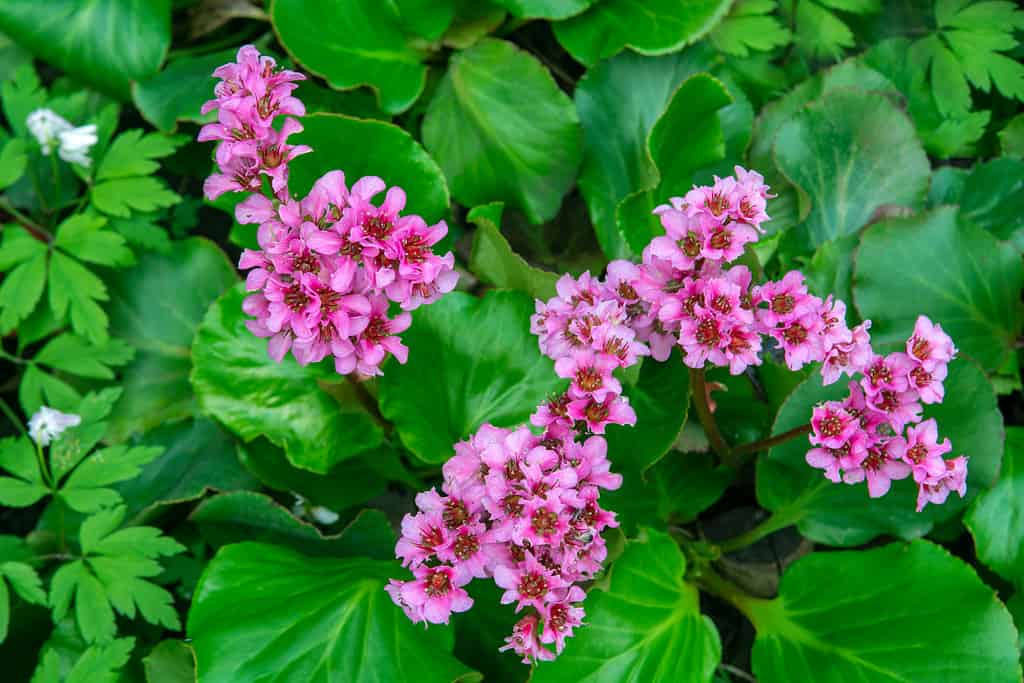
Bleeding Heart (Dicentra)
Bleeding heart plants are delicate blooming plants for shade gardens. The heart shaped blooms are very unique, but unfortunately short lived. The foliage is attractive in the early spring but can get a little tired later in the season, and may even go dormant. In sum, in the Spring, it is great as a showy spring specimen plant.
We carry varieties including the Alba, Gold Heart, King of Hearts, Luxuriant, the non-hybrid spectabilis, Pink Diamonds, Ruby Gold, Valentines and possibly more. This plant loves well-draining soil and hates clay soil that holds moisture. Don’t overwater it. So, ignore the tag that says keep evenly moist and water only when dry. We sell about 100 +/- each year in 6″ pots. We grow these plants in phases, so that they are available from mid-February through late April. This plant is an herbaceous shade-loving perennial.
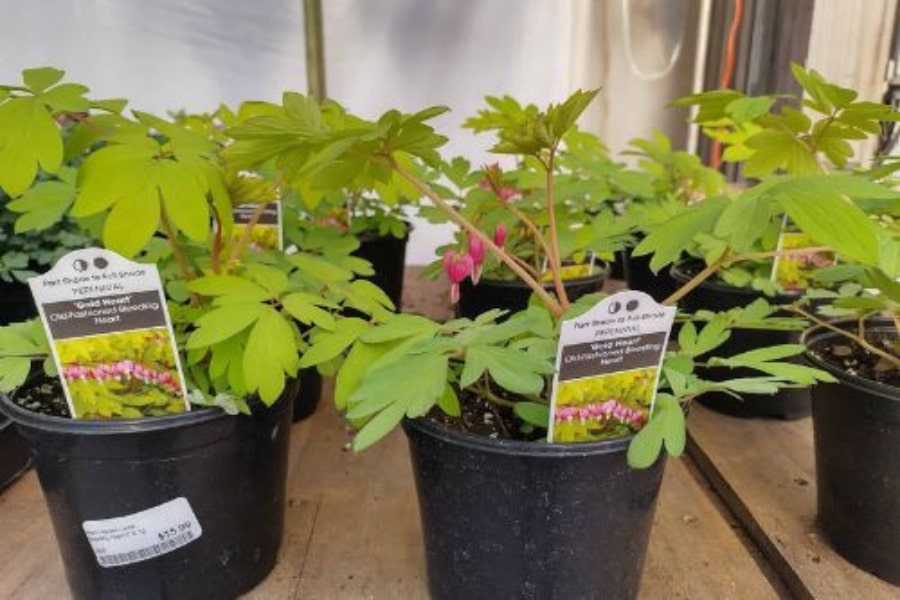
Bletilla (Ground Orchid)
Bletilla, aka, Ground Orchid and less commonly known as Hardy Orchid or Urn Orchid, is a boutique plant we carry occasionally as offered from one vendors. We usually sell 20-30 each year but there isn’t a lot of demand for it. Don’t know why. This perennial plant will naturalize if the conditions are right, specifically moist, well drained humic soil in the part-sun or shade. A great location would be a sloped area under a tree. It is herbaceous in the Upstate.
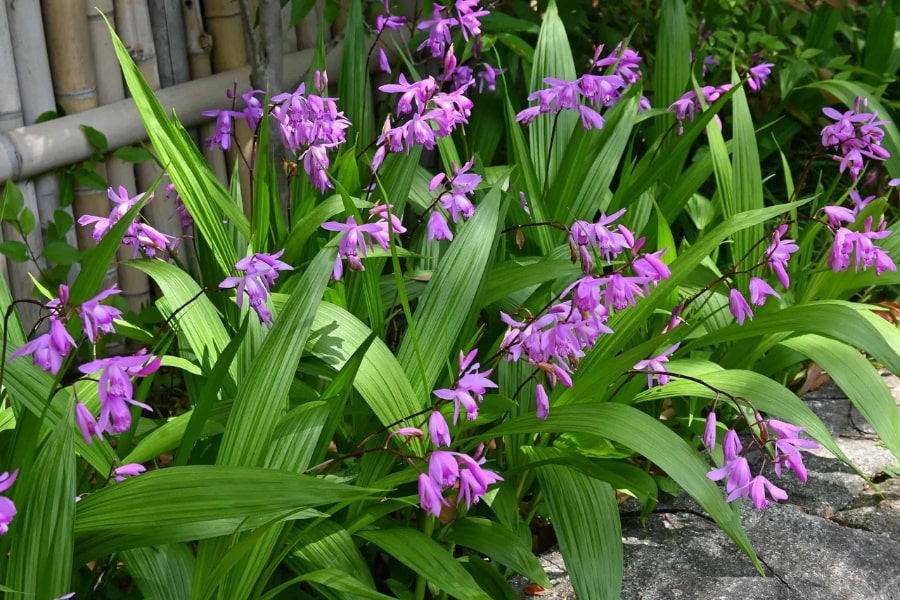
Brugmansia (Angels Trumpet)
Brugmansia are poisonous. But, customers want them anyway because they are beautiful and they are floriferous, often flowering all summer long. We have one vendor that supplies several varieties of Brugmansia in 3-gallon containers including Charles Grimaldi (dark golden-orange flowers), Double White (double white flowers) Maya with variegated leaves (peach flowers), Pink (pink flowers) and Velvet Rose (rose pink flowers). We will likely have the Brugmansia in stock in early April, and we will house them away from public passage for safety reasons. They will sell out within two weeks because we don’t have space for these types of plants. Watch our social media for the announcement when Brugmansia is available.
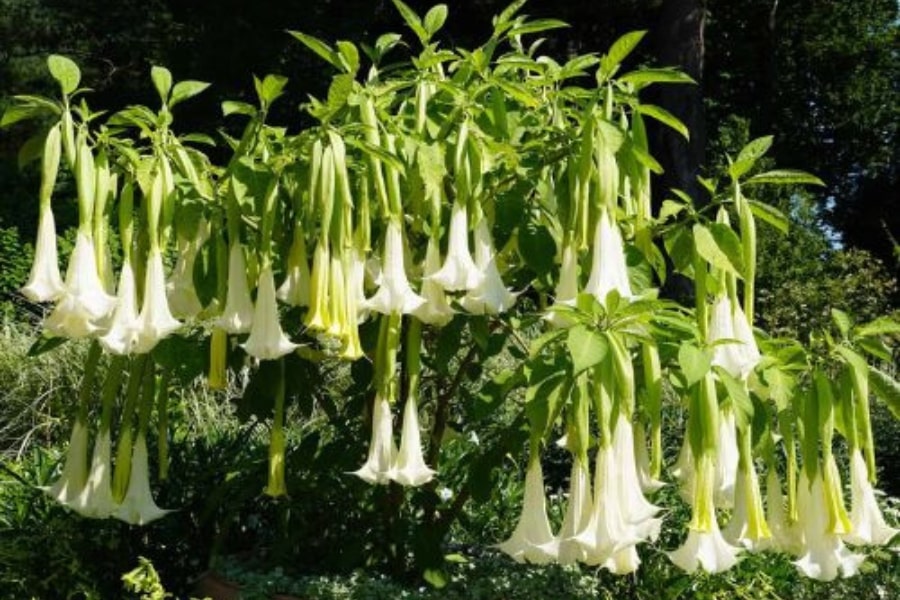
Brunnera
Heart shaped speckled gray green leaves with baby blue flowers in the spring. The foliage is the star, and the flowers are a bonus. We think the Jack Frost variety is extremely solid, but we are also offering the non-hybrid variety and the Alexander the Great variety in 2024. We also sometimes offer other varieties like Alexandria and the Queen of Hearts.
Note that like the Bleeding Heart, this plant likes well drained soil. So, ignore the tag that says keep evenly moist and water only when dry. We sell 50-100 Brunnera each year in 6″ containers and we grow them in phases so they are available from early March through early May before they sell out. This plant is a shade herbaceous perennial.
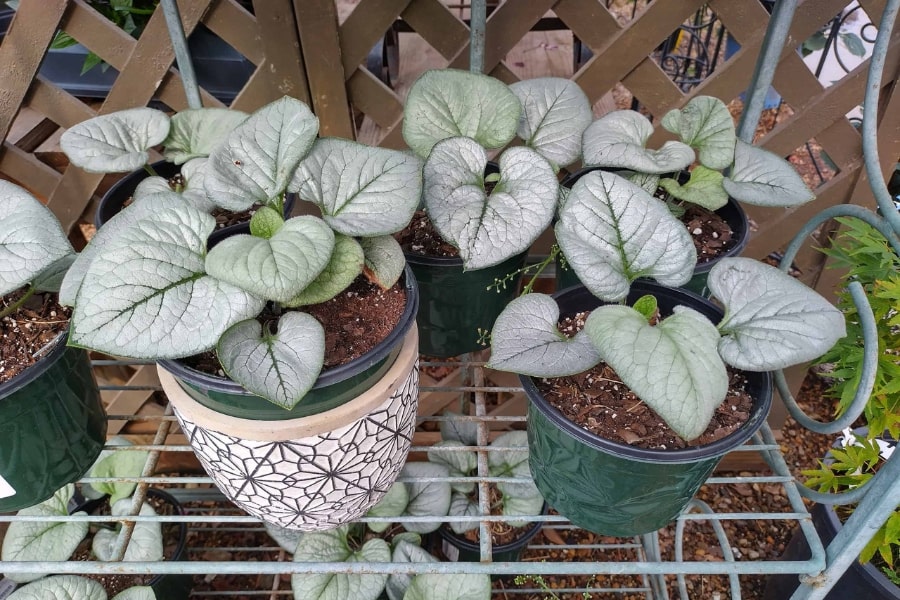
Campanula (Bellflower)
Campanula is amazing. Last year, one white variety bloomed from spring till first frost. And, the Dickson’s Gold variety is evergreen, or should we say ever-charteuse. Love, luv, lurve Campanula. We offer both 4″ and 6″ depending on the variety, and they are usually sold out by May. You will find them in our Mall area, and also in our Shade Perennial Arbor.
Campanula is a part sun to shade plant in the Upstate. Don’t let anyone tell you different. Northern tags don’t mean nothing! Otherwise, Campanula is an easy peasy addition to your shade garden that blooms almost the entire season. Varieties that we are offering in 2024 include, but are not limited to, Dicksons Gold, Rapido Blue, and Rapido White. Also note that these varieties are not the creeping varieties that are considered invasive.
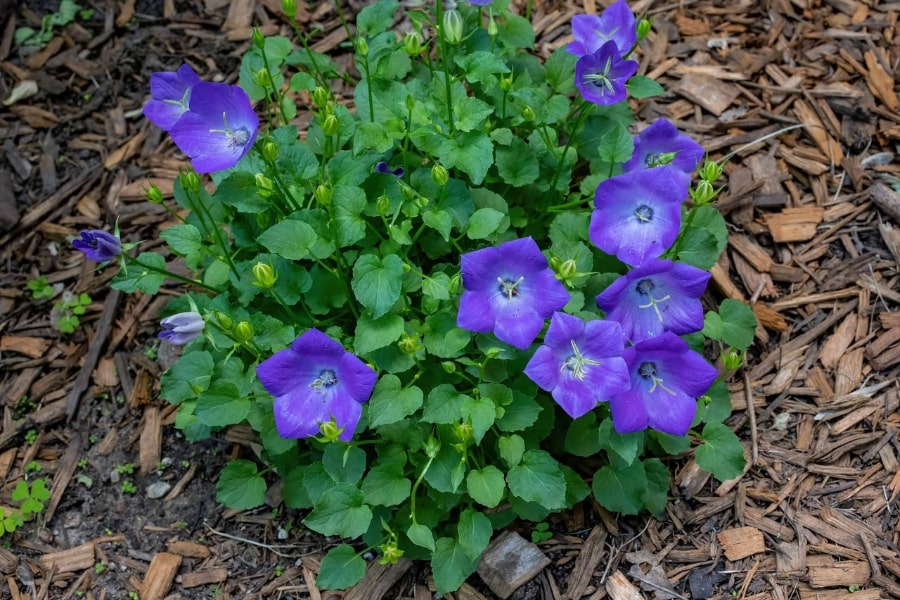
Canna
We try to carry Zone 7 cold tolerant Canna in the spring and by summer, most have sold out. Canna are a tuber and water plant. Canna prefer afternoon shade in the south but can be grown in full sun and full shade. See our Canna page for more information about commonly found Canna in our area. Canna is a water plant. So keep it moist and expect it to grow exponentially.
Each spring, we host a Canna tuber sale, and you must be on our mailing list to receive information about the sale. Any leftover tubers are planted in 1-gallons in the spring. They grow so fast that they must be transplanted in July to 3-gallon containers, and they are typically overflowing the 3-gallon pots within one year. We also purchase Canna pots in 1- and 2-gallons from our vendors.
Canna is relatively pest free until the Japanese beetles arrive in Late May, Early June. They can devour a plant in one day. Either crush them by hand or use the organic Bonide Japanese Beetle Killer Spray. This plant is an herbaceous perennial.
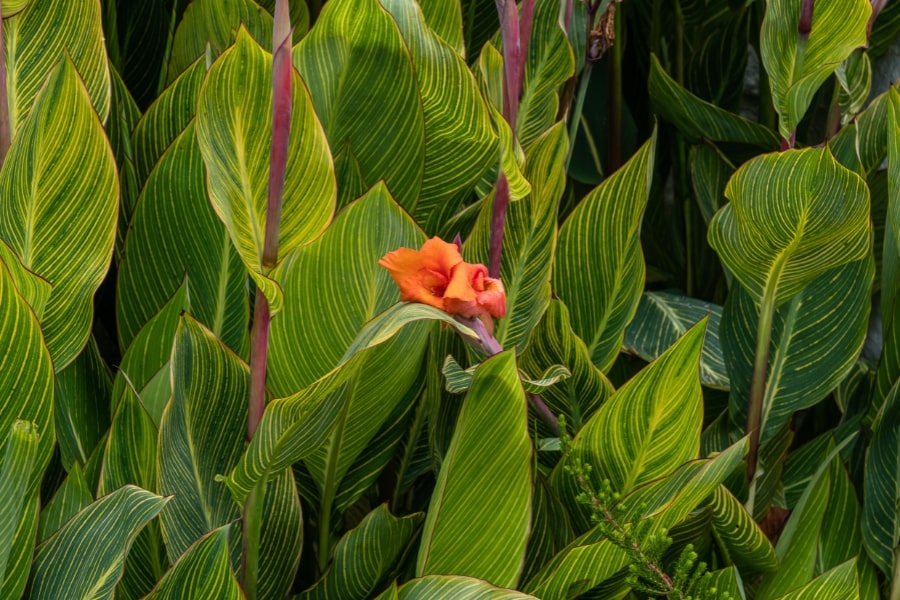
Cast Iron (Aspidistra)
The cast iron plant is a popular evergreen thriller in shade pots due to its height. Be extra careful with the water. It likes to stay on the dry side so pair it with other plants that like to stay dry. Fillers like heuchera (coral bells) and spillers like ivy are great companion plants, as all of these like to remain on the dry side.
Cast Iron plant can withstand amazing drought. But, if you cut it back, it will take almost a year to rebound. Note that cast iron plants are mite magnets. So check regularly for mites and treat immediately with Bonide’s Neem Oil if mites are found. Repeat treatments will be required. We sell about 100 plants each year in sizes ranging from 1-3 gallons, and we do our best to keep Aspidistra stocked year-round.
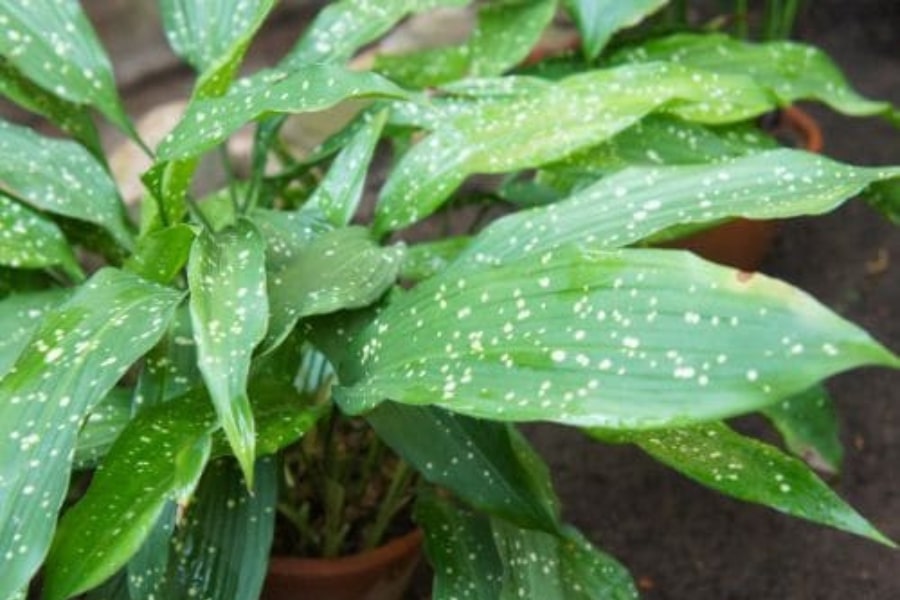
Centaurea montana (Mountain Cornflower)
Centaurea montana, often referred to as Bachelor’s Button, is known by far too many other names than should be listed here. For the past several years, we have been growing several of the “Amethyst” varieties. In 2024, we are growing the Amethyst Dream and Amethyst in Snow Centaurea.
These beauties are available when they bloom in early spring, March-ish, and may rebloom later if you deadhead. The soft grey foliage heightens the beauty of the plant. We generally sell out by late-April. This plant is an herbaceous perennial.
Convallaria (Lily of the Valley)
Every year, we bring in the short blooming lily of the valley, and every year we sell out in a flourish. Convallaria acts as the perfect under-canopy plant, spreading by underground rhizomes and sending up stout petals. In the early spring, Convallaria produces the sweetest smelling tiny arches of blooms. Plant it under a tree and it will flourish … after taking a year to get established.
Lily of the Valley don’t like to be moved once planted but if you do move them, expect them to pout and go dormant for about one year until their root systems are reestablished. These plants DO NOT like to be pampered or overwatered, so water sparingly. This is an evergreen perennial in the Upstate. In 2024, we were shorted our Lily of the Valley pips so we may not have any to offer this year. Great sadness. We are scrambling now to try to find sources, but it may be a very sad year indeed.
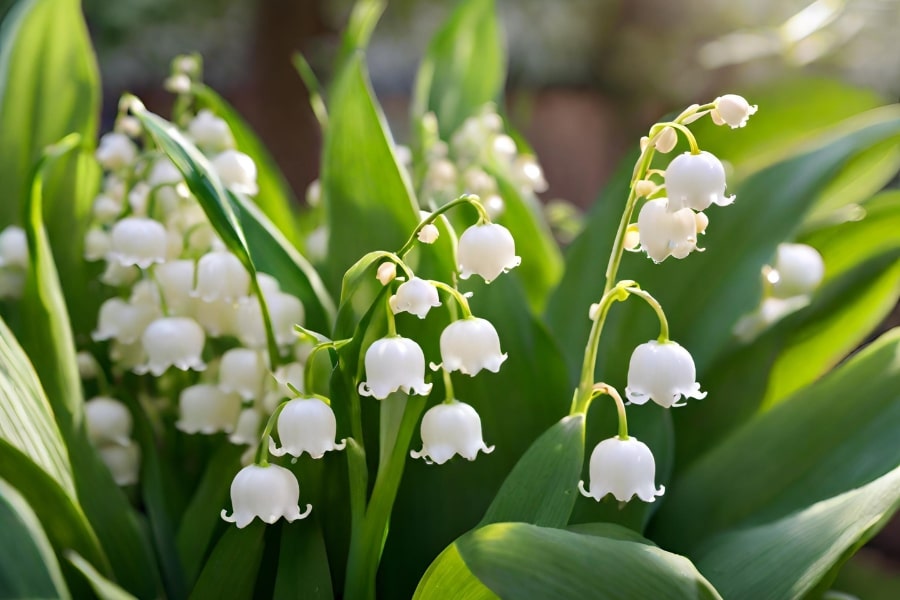
Dahlia
Dahlia are tender Zone 8 perennials. We carry two patio Dahlias, the GoGo Series and the Single Wink Series because we have a fantastic vendor that offers these types. We also offer some of the Dinnerplate Series, which require staking. For the past several years, we have conducted a tuber sale in early spring circa late-March, and any tubers remaining we have potted up for early summer sales.
Dahlia bloom all summer long and are amazing cut flowers. Their only problem is they are a tender perennial. Consequently, when it gets down to 10F at Christmas, there is a distinct possibility that a tender tuber stored outside may not survive. It’s always smart to put 3-4 inches of mulch on your in-ground Dahlia tubers after first frost kills the foliage, and then move it away in late spring after the threat of heavy frost has passed. See our Dahlia page for more Dahlia varieties, and our Dahlia Care Guide for an extensive Dahlia care summary. Dahlias attract pests and the care guide will provide you with diagnostic information.
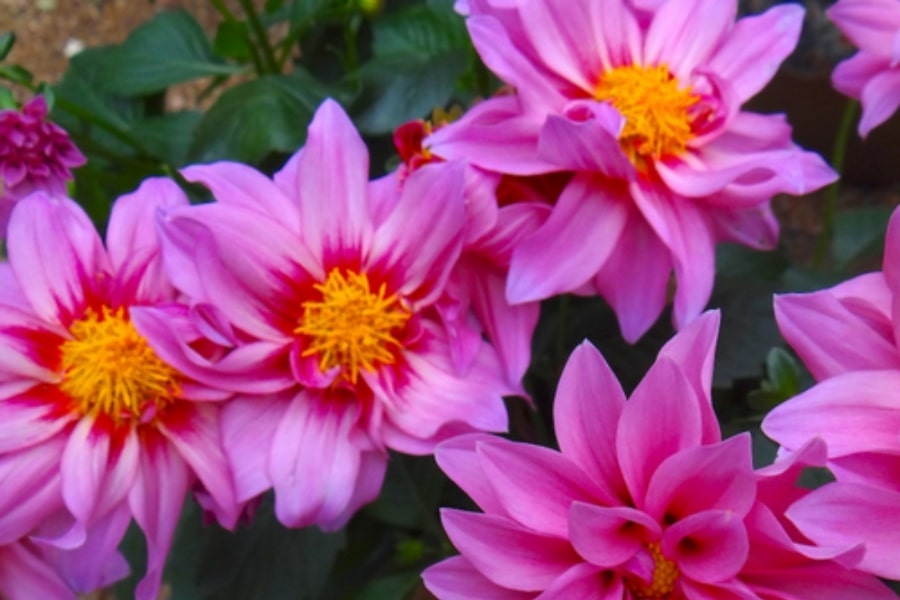
Daylilies (Hemerocallis)
In the early and late summer, Daylilies finally have their time to shine. We usually see Daylily blooms in the South Carolina Upstate in June and July. Each Daylily stem usually carries 2-4 blossoms and each blossoms last a day, hence the name Daylily. Our 2-year old plants will likely send up 3-5 stems.
We sell 300-500 Daylily each year and we stock 20+ varieties year-round though in the winter, they are essentially buckets of dirt. You can see pictures of our amazing Hemerocallis on our Daylily Page. Hemerocallis is an herbaceous perennial although some of the fans remain above the ground in mild winters.
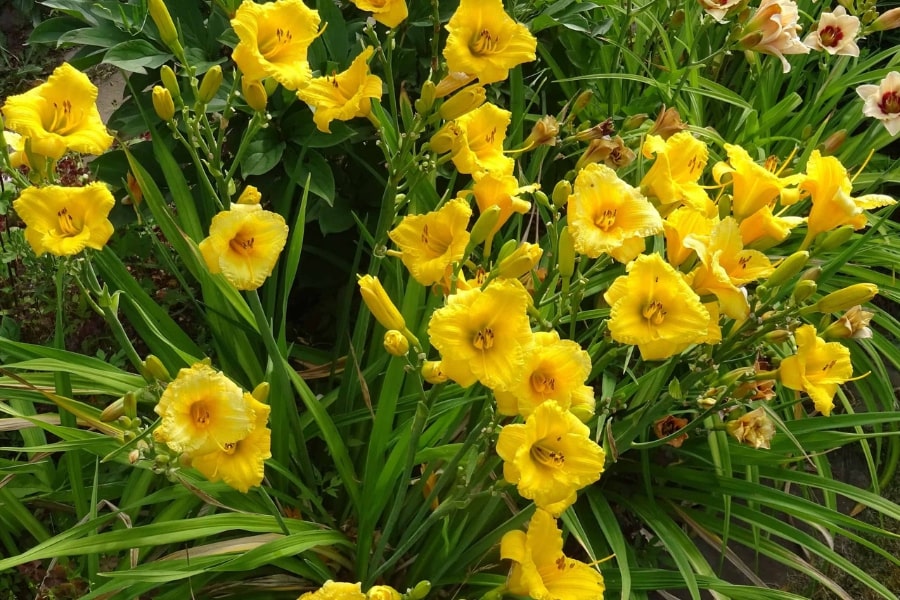
Elephant Ears (Colocasia)
Elephant Ears are fantastic back border or specimen plants either in the full sun or full shade. They are more successful in afternoon shade, though. Colocasia grows quickly, taking a season or two, max, before reaching full size. And, if you fertilize, you will really see some growth. Mites love Colocasia. So, be prepared to treat for mites in the late summer or early fall if you own elephant ears. We recommend repeated dosing of Bonide’s Neem Oil, an organic chemical.
We oftentimes grow Elephant Ears but much is dependent on our successes in obtaining starts. If not, we bring them in from our vendors. We try to carry Elephant Ears in 1-gal beginning in April but by July, they have outgrown their containers and must be potted up into a 2-3 gallon. In sum, buy early before the size and price goes up. Elephant Ears are herbaceous in the Upstate.
Epimedium (Barrenwort)
Oh, my oh my. This neglected shade perennial is making its comeback. The low-lying heart shaped leaves of multiple colors provide the carpet and or mound that accentuates the tiny blooms on delicate stems that rise above. This is a late spring bloomer, beginning to show in May.
In 2024, we are growing the Amber Queen and Pretty in Pink Epimedium varieties. Get them in early spring if you can. Barrenwort is herbaceous in the Upstate. In the fall, leaves may take on an autumnal hue adding interest to the shade garden.
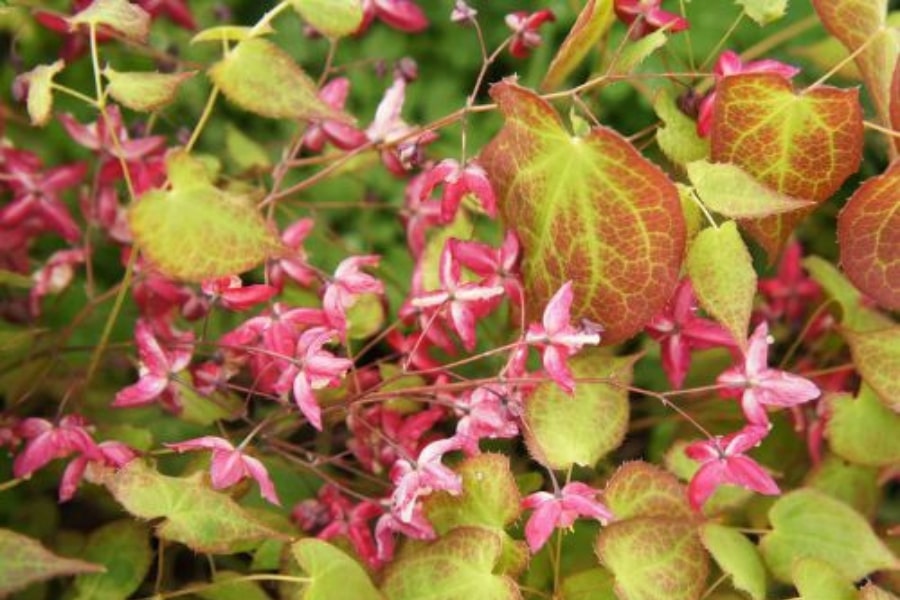
Eucomis (Pineapple Lily)
Not many Upstate gardeners are familiar with Eucomis but they should be. At Martin Garden Center, we have grown Eucomis two different years, and we usually have leftovers for the following year. Makes you wonder why when you see the magnificence of this plant. Plus, it is super easy to care for and so, so unique. No other of our vendors are carrying Eucomis and we are not carrying it in 2024. So, only by a miracle will it be available in 2024. But 2025 is another year so wait for it and show some enthusiasm in buying it and maybe we’ll stock it regularly! This plant is an herbaceous perennial in the Upstate.
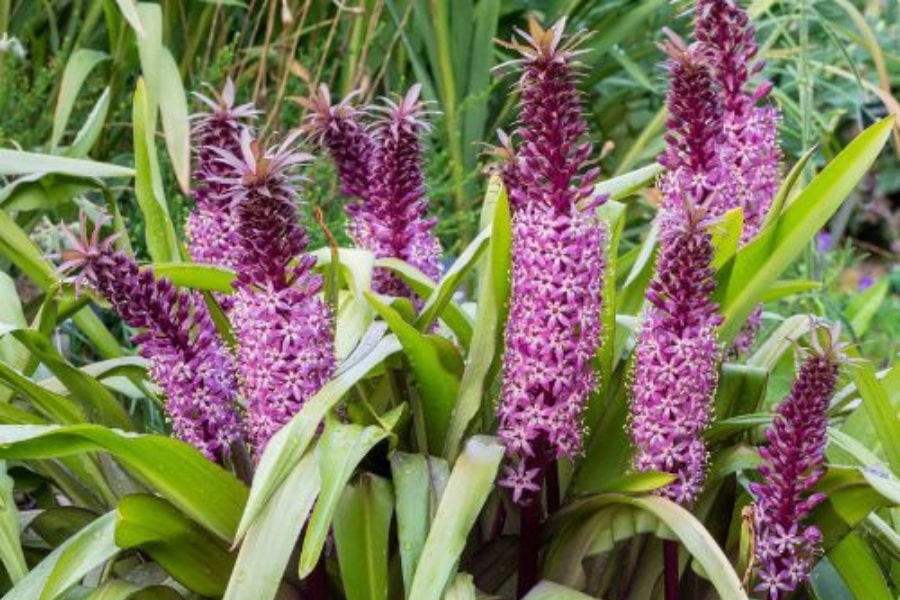
Eupatorium (Joe Pye Weed)
Joe Pye Weed is a native wildflower that withstands drought and poor soil better than most plants. It also is an important source of nectar for the Monarch Butterfly amongst others. The original Joe Pye Weed stands about 5 feet tall and blooms in late summer. It was considered a meadow flower. The hybrids tend to be more compact, thus becoming more attractive to the typical gardener who doesn’t own a meadow.
We have grown Joe Pye Weed hybrids in the past but now we rely on our vendors as our source. Normally, these plants come available in late summer, right before they bloom. Joe Pye Weed is considered an herbaceous perennial plant in the Upstate.
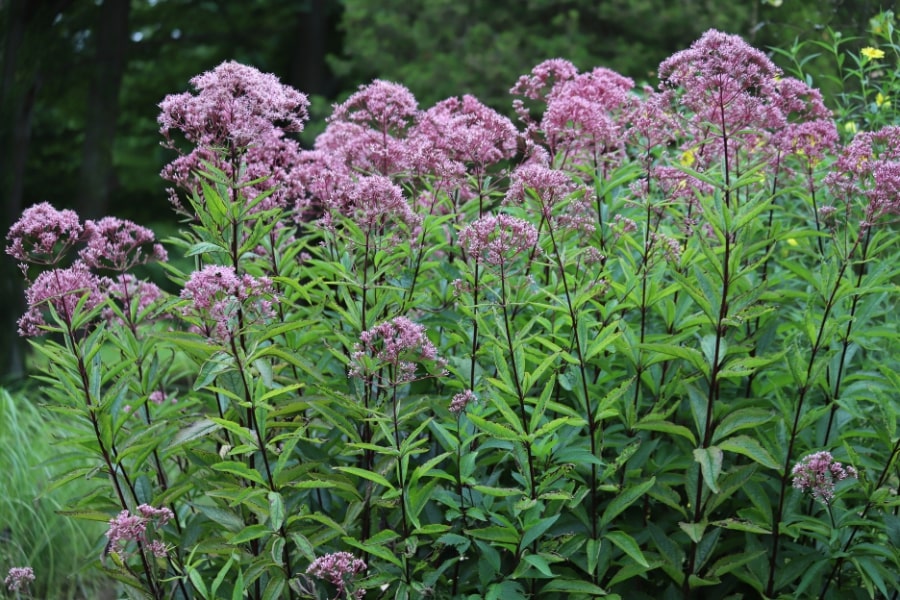
Farfugium (Leopard Plant)
In the last 5-6 years, the demand for Farfugium has taken off. We’ve gone from selling 50 to selling more than 250 each year and that is only if we can get them, because sometimes we can’t. All are evergreen perennials in the Upstate. There are numerous types of Farfugium. The most well-known is the Giganteum (aka, Tractor Seat Farfugium) which gets 3X3 in 2-3 years. There is also Shishi Botan (ruffled and crinkled leaf), Aureomaculatum (yellow dotted), variegata (white variegation), and crispata (ruffled leaf).
We can’t keep this amazing evergreen perennial in stock due to the heavy demand. Luckily, we now have numerous vendors who grow it in 1-3 gallon containers, thus helping to make this plant available to our customers almost year-round. We won’t always have all varieties, and we won’t always have this plant in stock, but we will try. We haven’t had pest problems with Farfugium with the exception of the occasional Aphid finding. Spray with organic Bonide Insecticidal Soap at least two time if Aphids are found. Again, these plants are evergreen in the Upstate.
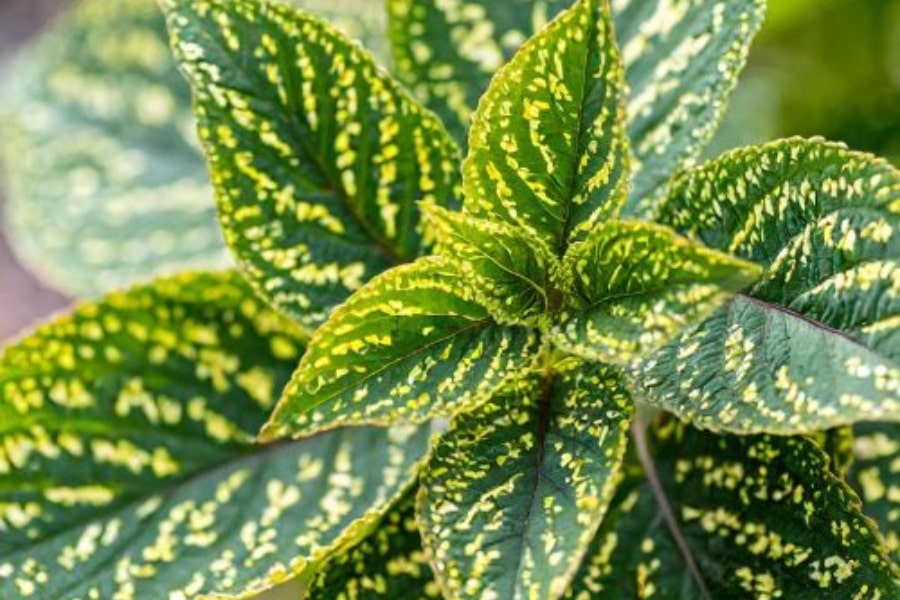
Fatshedera (Bush Ivy)
This new species resulted from the cross between Fatsia and Hedera (Ivy), hence the name Fatshedera. We carry 2 species, namely Lizei (green leaves) and Angyo Star (green leaves edged in cream) that we obtain from one vendor. Generally, our vendor supplies 2-gal containers but 1-gallon and 3-gallon are also sometimes available. Because we rely solely on one vendor, our stock is oftentimes sporadic.
Fatshedera is often used as a thriller in part-sun and shade pots. It is an easily maintained non-fussy plant with the exception that it is susceptible to mites, which seems appropriate given that both ivy and Fatsia are also mite attractors. Spray with organic Bonide Neem Oil at least twice to eradicate any mite problems. This plant is an evergreen perennial.
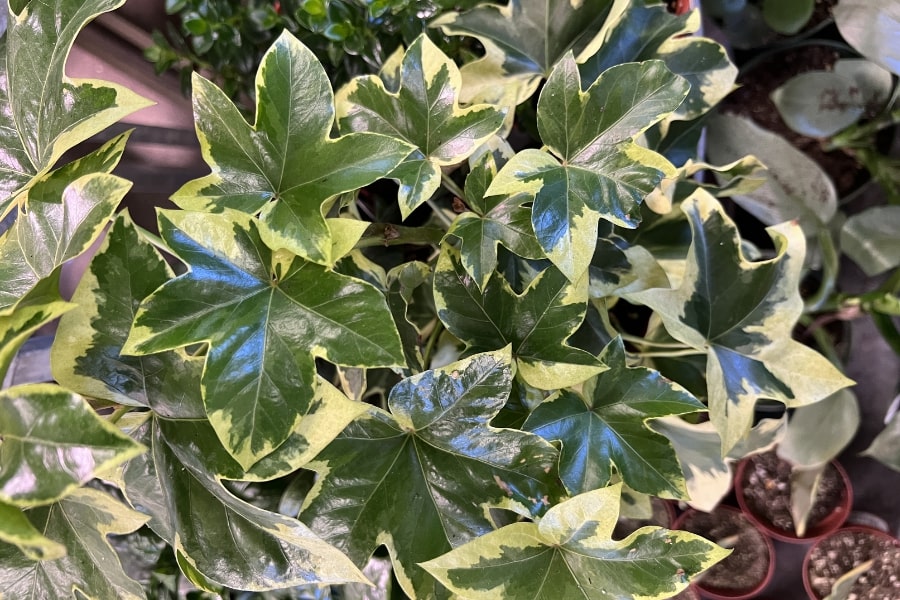
Ferns
We carry numerous varieties of perennial fern and would carry more if we could find them. Our most popular perennial ferns include holly fern, autumn fern, japanese fern and ostrich fern. See our Fern page for an extensive list.
In the Upstate, not all ferns are true evergreen ferns. The short list includes arborvitae, holly, fortunes holly, and east Indian holly. The Autumn fern acts like an evergreen, because it remains upright during the winter. But in the spring, the old fronds fall to the ground while the new fiddles reach for the sky. A true evergreen’s growth continues to grow year to year.
Ferns commonly struggle with worms and caterpillars. Moths and Butterflies abound and can fly onto your fern and lay hundreds of eggs that turn into tiny worms and caterpillars. Bonide’s organic BT can be used to eradicate these pests.
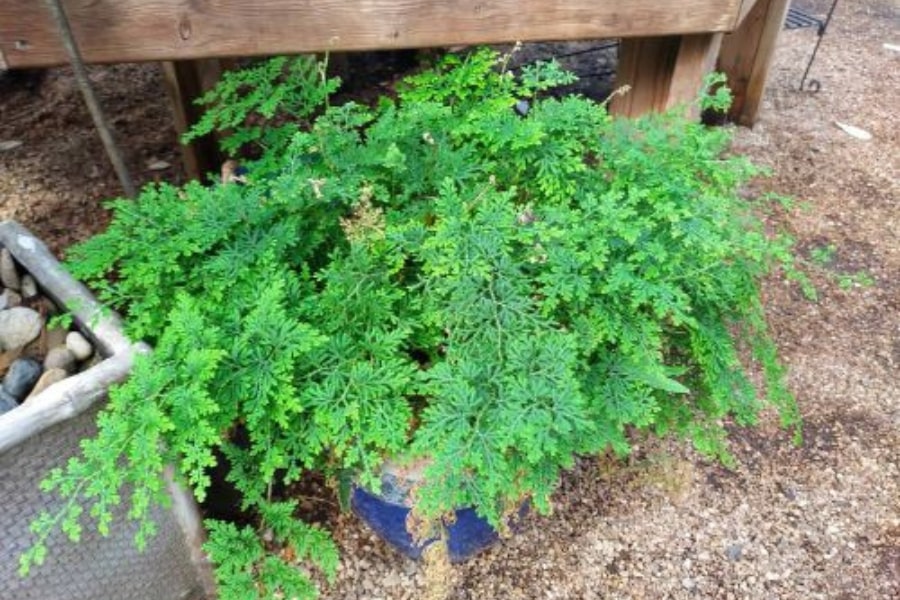
Gentiana
There are few true-blue flowers and Gentian is one of them. There are two varieties that we have grown in the past at Martin Garden Center but the only one to speak of is True Blue Gentian. We loved True Blue Gentian. But truth be told it was an aphid magnet, so after several seasons, we stopped carrying it.
As a plant connoisseur, if you are willing to battle the Aphids, there is nothing more beautiful than this plant’s upright and trailing branches blooming in glorious blue amongst your shade garden. It booms beginning in the spring and continues until first frost. Note that it is listed as a Proven Selection by Proven Winners as only a Zone 4-7 perennial, but it thrived in Zone 8 as well … so fear not lovers of blue in Zone 8 … just fear the Aphids (that are easily treated with Bonide Insecticidal Soap (repeat within 7 days when Aphids present). In 2025, we will again bring in Blue Gentian to grow and sell because we miss it so much.
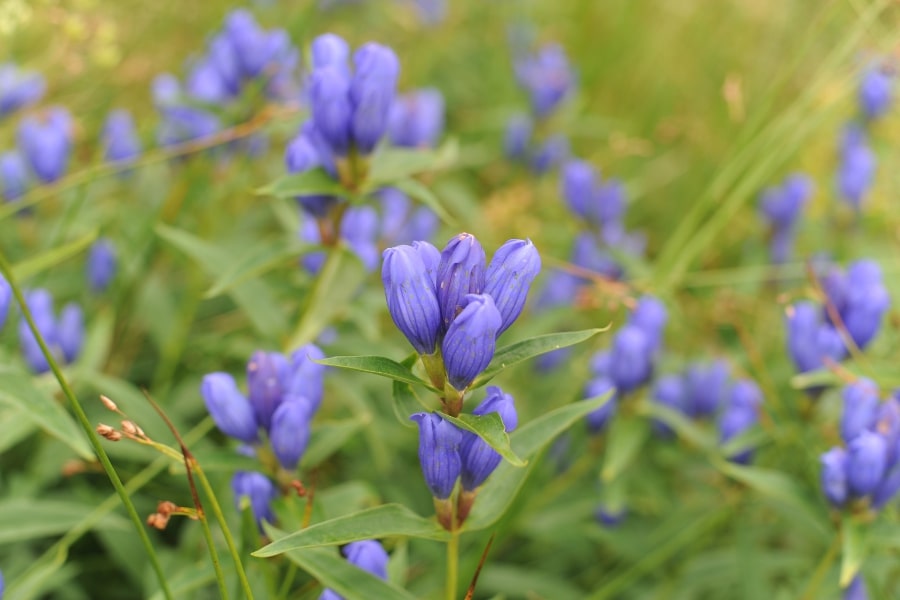
Hardy Geranium
Martin Garden Center customers love hardy Geraniums, also known as Cranesbill Geraniums. Over the years, we have probably grown every variety that we could find including the ever-popular Rozanne, Max Frei, New Hampshire Purple, Johnsons Blue, and more. In 2024, we are growing Rozanne in 6″ containers and we will supplement these with offerings from our vendors. This plant is a sun-loving herbaceous perennial.
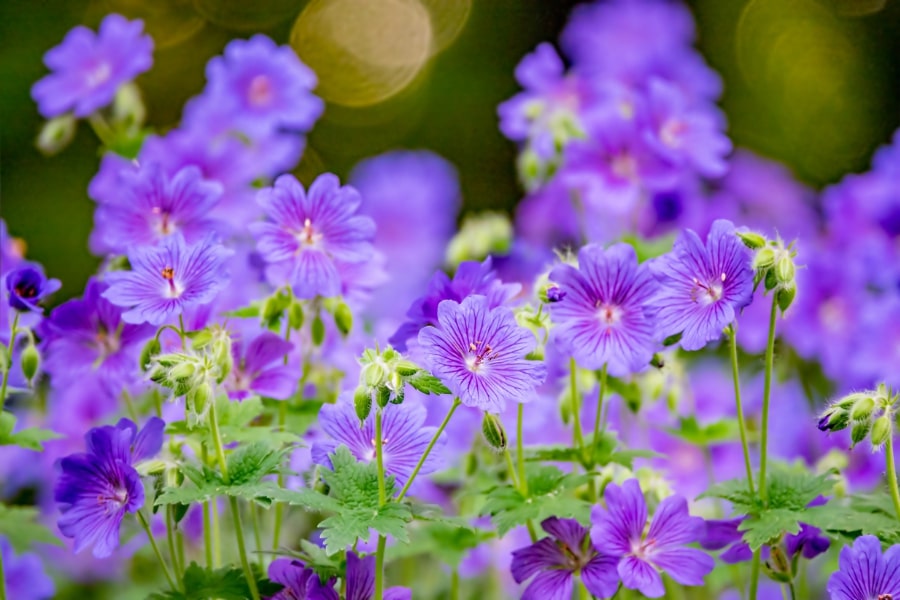
Geum
Geum, less commonly known as Avens, has made a comeback in the past years due to some amazing hybridization, making the plants more hardy and more floriferous. In 2024, we are growing two varieties, specifically Pretticoats Peach and Red Dragon, and both will bloom in flushes throughout the summer. Ignore the tag that says they take full sun … in the Upstate they should be planted in afternoon shade. Deadheading will help in keeping these beauties looking their best. This plant is an herbaceous perennial.
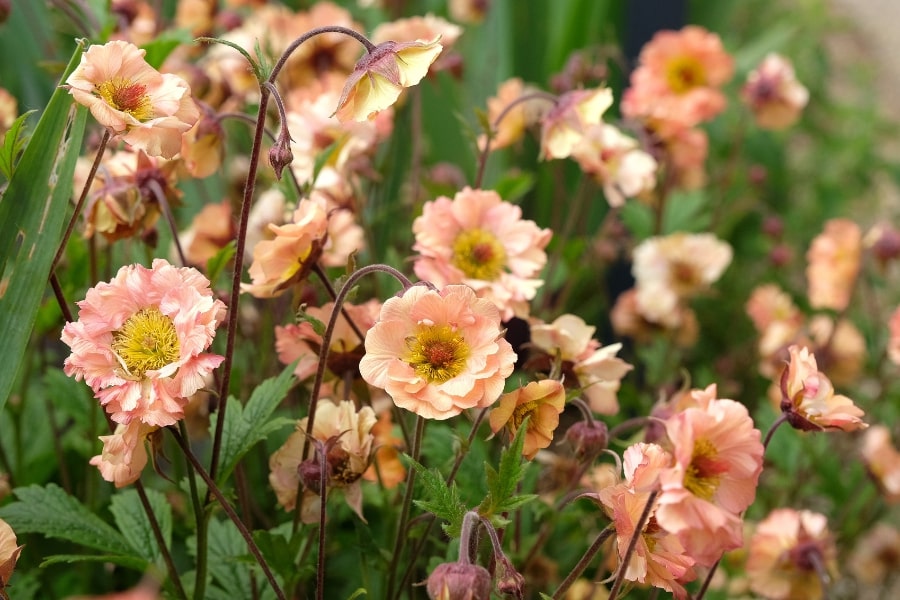
Goldenrod (Solidago)
Goldenrod has become a far more popular plant in the last 10 years as xeriscaping and native species planting has become more popular. Years ago, along with Joe Pye Weed, it was considered an invasive weed. Now, its celebrated. Go figure.
We have grown Solidago in the past and will grow it in the future, just not in 2024. Consequently, we are reliant on our vendors who have come through for us. This herbaceous sun perennial is generally available in the late summer, right before it flowers.
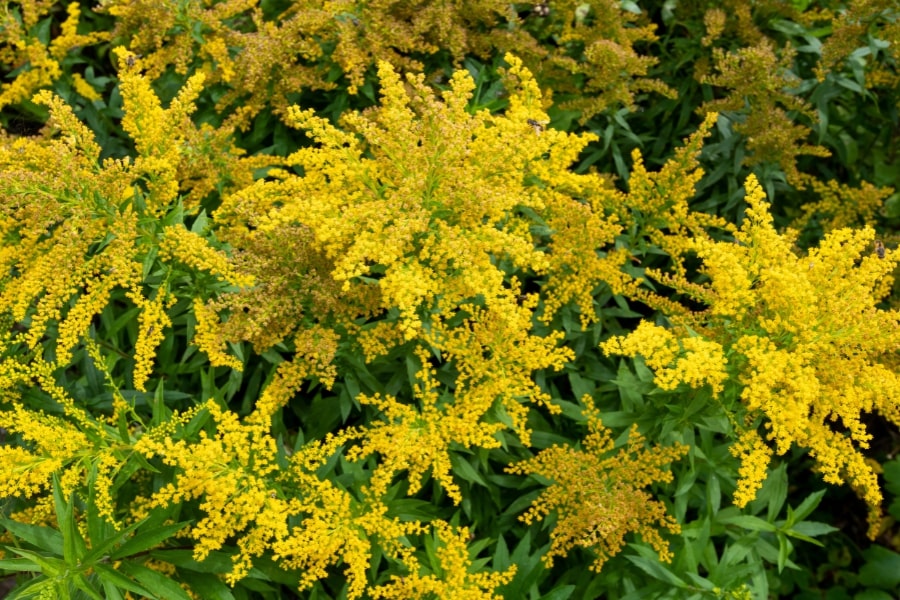
Hellebore (Lenten Rose)
Lenten Rose prices have skyrocketed over the past few years. Much of this is due to a new viral pathogen, Helleborus net necrosis virus (HeNNV), which is referred to as the black death and it affects the Helleborus orientalis, which is the commonly found Hellebore. Most growing nurseries no longer grow the orientalis because of its susceptibility to the Black Death.
Once infected with HeNNV, the hellebore will die. It is wise to avoid combining existing hellebore with new hellebore that have the potential to be infected. In the meantime, to increase your hellebore population, take the new seedlings that self-seed from your hellebore and pot them up. They are biennial so don’t expect them to flower for 2 years. But at least you can help grow your populations or Hellebore orientalis until a cure is found.
We sell 100-200 Hellebore each year if we can. We begin to see them around Thanksgiving, and we rarely see them past March. Some years they just aren’t available so we can’t sell them. Watch our social media because we always announce when we score a Hellebore shipment. Hellebore is a cold season perennial evergreen, usually sending out new growth in February ahead of its blooms, which also happen in February. It makes a great cut flower.
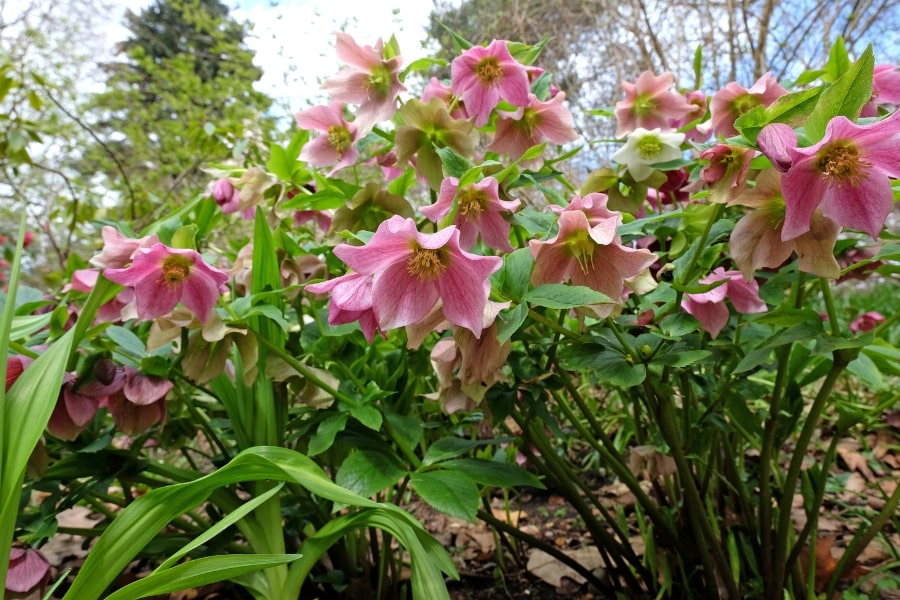
Hosta
In 2022, we sold more than 1000 Hosta and carried more than 30 varieties. The great thing about Hosta is that it does best when left alone. A feeding in the spring and fall, and watering during drought, and Hosta are happy. Fuss over it and overwater it, watch it die. Hosta continue to grow and multiply in shady areas. But Hosta do not like a lot of sun and will look very ragged or die with too much sun exposure. Hosta come in many sizes from tiny Mouse Ears to the ever-popular Empress Wu, which reaches 4-6 feet in height and width. See our Hosta Page for more information on Hosta that we carry. All hosta are herbaceous perennials.
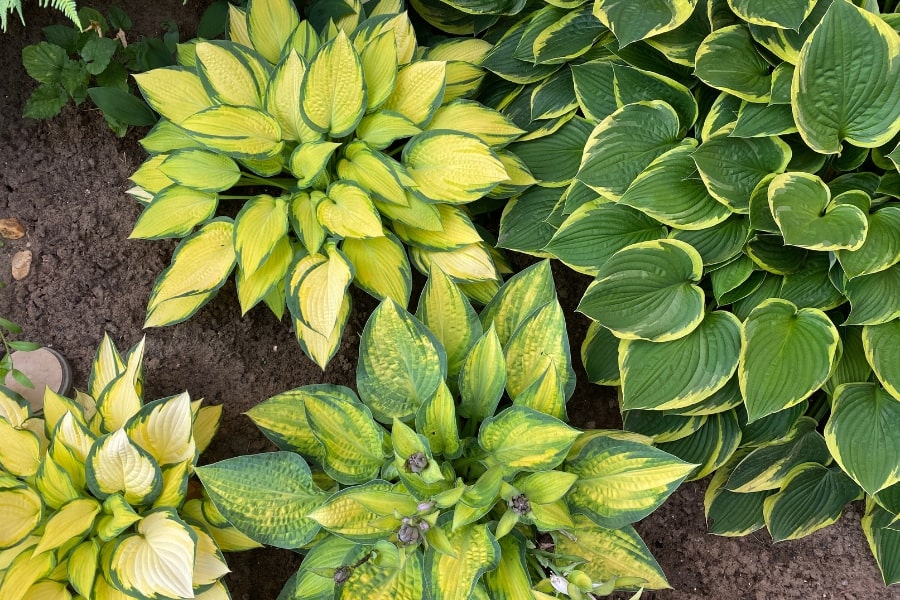
Liatris
Liatris, commonly known as Gayfeather and Blazing Star is a garden must have. The varieties we carry, spicata Kobold and Alba, are amazing bee attractors and are favorites at Martin Garden Center. Liatris tend to flower in late summer, early fall, thus providing a boost of color to a late summer garden. It is an herbaceous sun-loving perennial plant.
We sell hundreds of corms each year during our online bulb sales conducted in February and/or March, and we pot up the rest. You must be on our mailing list to receive information about our bulb sales.
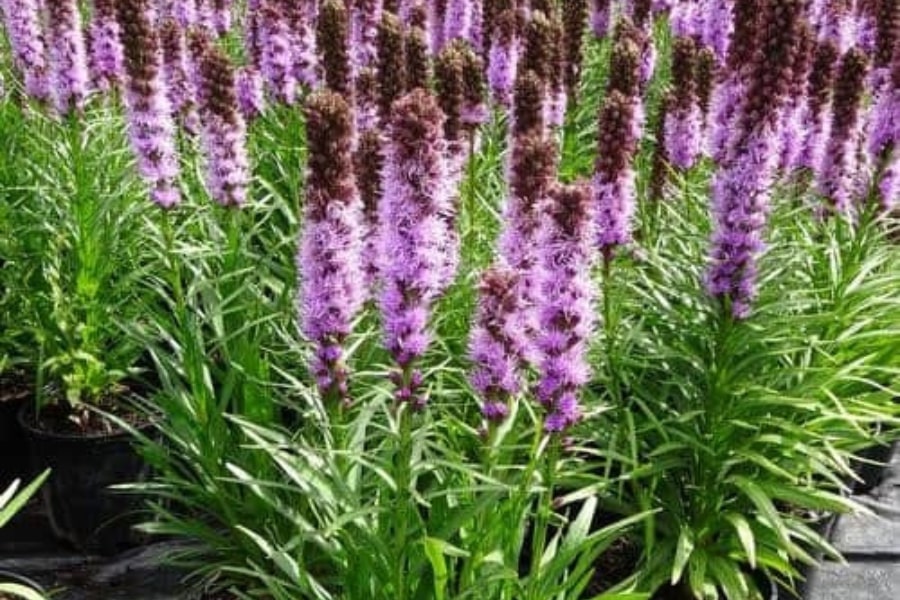
Ligularia (Leopard Plant)
Ligularia and Farfugium were once considered to be from the same family. Consequently, they both have the same common name … Leopard Plant. We have grown several varieties of Ligularia, including Rocket and Little Rocket and these plants take up some room … 5X5 for Rocket and 3-4 feet tall and wide for Little Rocket. They are perfect additions for under large trees or to take up space in large shade gardens.
For Ligularia, the heart-shaped, coarsely toothed leaves of the foliage are the star, and the rocket of yellow blooms on chocolate-colored stems is just the bonus. Crazy adorable. We will grow this plant again because no one else grows it. We may not have any available in 2024, but we will have it again. This plant is an herbaceous shade garden perennial.
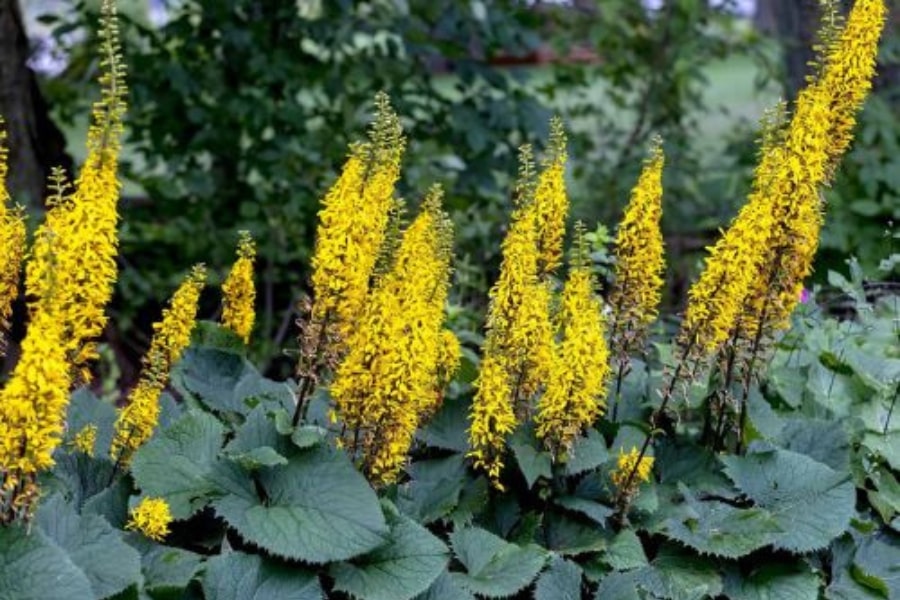
Lilies (Asiatic, Oriental & Specialty)
Every perennial garden should feature small groupings of lilies. After the first flush of spring blooms, lilies finally explode in full bloom. They are great cut flowers. You may want to remove the stamens before taking them indoors to save yourself time in dusting pollen. These lilies and their pollen are poisonous when eaten so think about the placement in your garden. We sell 100-200 each year both as part of our online bulb sales and in 6″ or 1-gallon pots. See our Lilies Page for more information. All lilies are herbaceous perennials.
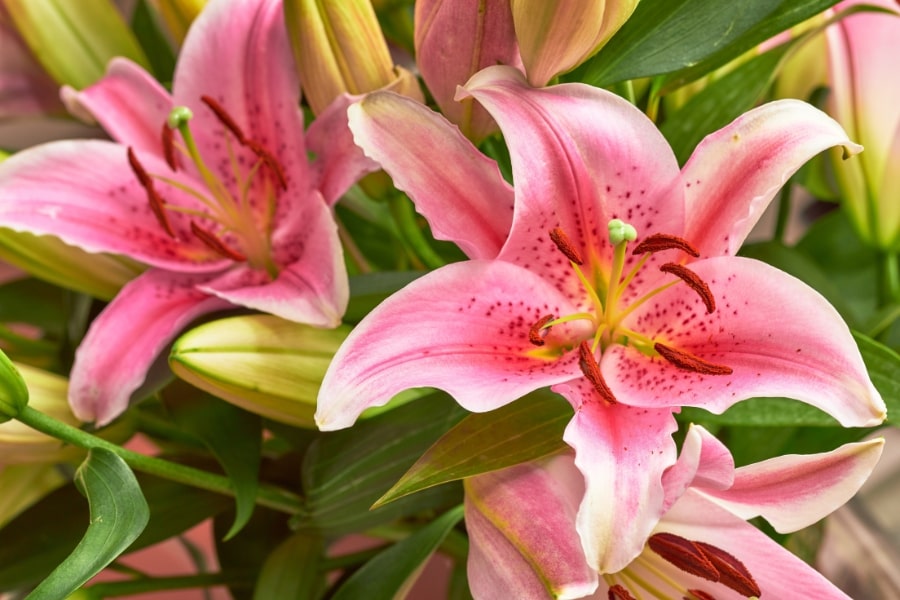
Arum (Lords and Ladies)
The rare Lords and Ladies plant is also a rarity at Martin Garden Center. We have carried it on two occasions when made available by our vendors. It is poisonous and it can be invasive. Hmmm? Yet gardeners familiar with the plant love it for its unique blooms in late April early May, followed by its colorful fruit in the fall. Since it’s been several years since the last crop, perhaps we may see it in 2024. Perhaps not. We’ll let you know via our social media. This plant is semi-evergreen in the Upstate.
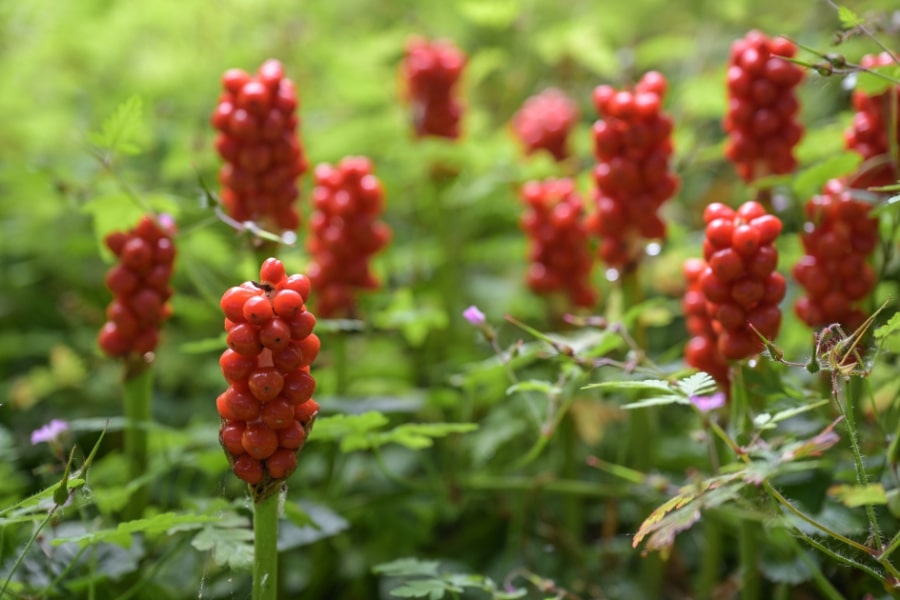
Malva
We’ve grown the Malva sylvestris ‘Zebrina’ for two years now and it is gorgeous. The limitation … it is subject to deadly rust. So, we keep the plant under plastic in our Sun House until it is sold, and we have a big honking sign that says “Buyer Beware … rust issues.”
Pine trees are a natural carrier of rust, so we protect Malva in our covered Sun House. Any buyer of this plant must also protect it. However, if the buyer can avoid planting near pine trees and other rust carriers, this little beauty has great potential. This plant is an herbaceous perennial.
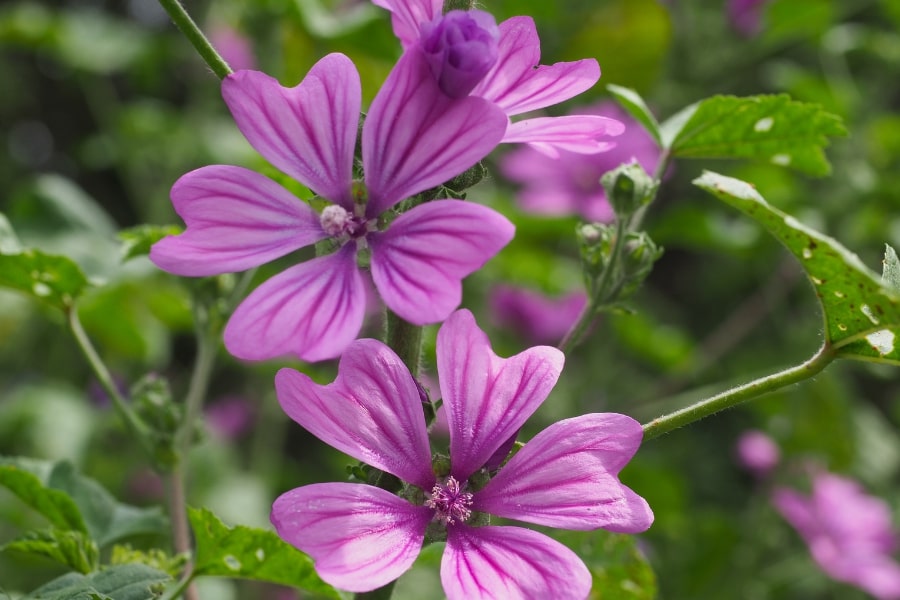
Meadow Rue (Thalictrum)
You rarely find meadow rue in Upstate South Carolina gardens anymore, but it once was an old timer’s favorite. Many older homes will still have small gardens with meadow rue. Not quite sure why it fell out of favor because it is super drought tolerant and bug & deer resistant, plus the foliage is gorgeous … and then there are the fuzzy blooms in late spring/early summer of pink, white, lavender or blue. In the 2024 year, we are growing My Little Favorite, a lavender bloomer.
Meadow Rue is a meadow flower and is easy to maintain. Ignore the tag if it says full sun, and plant it in the part sun. Amend our lovely compact clay soil to ensure it is well draining. You will have to water meadow rue in the summer heat, but if the foliage turns yellow and you cut it back or it dies back, the roots will survive and come back the following year. This is an herbaceous perennial.
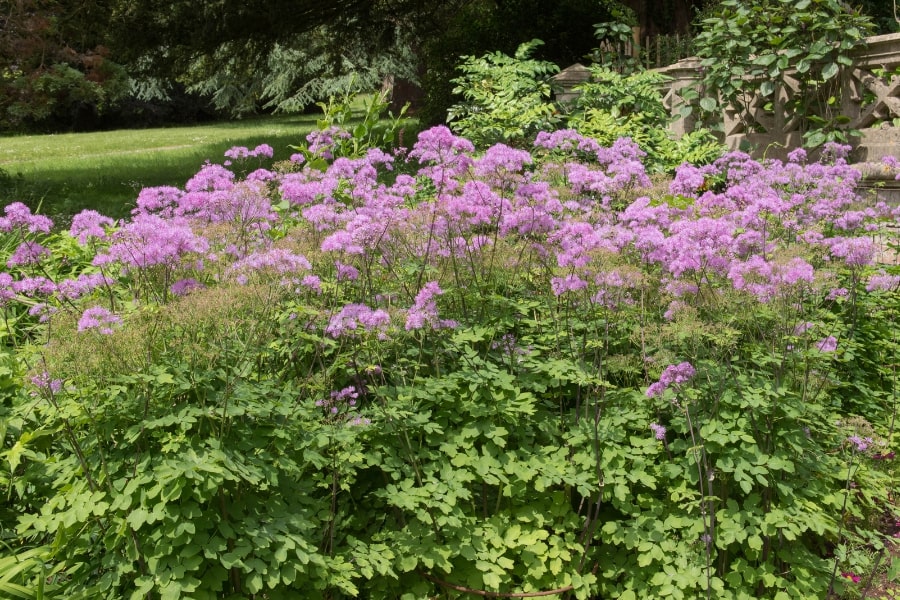
Meadowsweet (Filipendula rubrum)
Meadowsweet, aptly named the Queen of the Prairie as it towers over most other flowers at 5-6 feet, is another of the overlooked native wildflowers. The Queen of the Prairie may not be for every gardener, but for some, this will be a must have. In 2024, we are growing the gorgeous award-winning variety, Venusta, with sprays of deep pink that fade to soft pink in early to mid-summer. Wow. Just look at that picture! This herbaceous plant will require full sun with regular watering because unlike most of its wildflower friends, it does not like drought.
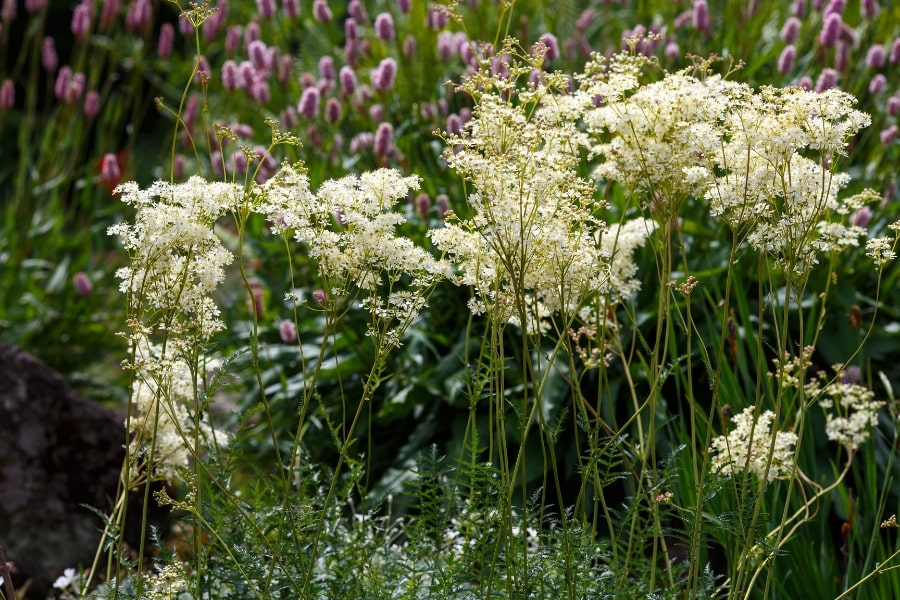
Mexican Petunia
Martin Garden Center sells 200+ 6-8″ Mexican Petunias each year. This floriferous purple beauty is a gift that doesn’t stop giving, flowering all summer until first frost. Its only 2 downsides … 1) it can be a bit invasive and 2) it is dormant almost until May, thus causing its owners to believe it’s dead. We start receiving our greenhouse-grown Mexican Petunias in late April thus causing the panic. But trust us and wait till June before you decide to replace your old herbaceous perennial Mexican Petunia because it is likely coming back … with a flourish.
We attempt to stock this plant from Spring through Fall. We haven’t had a lot of pest problems with this plant, though we do watch for mites, and we do regularly preventatively spray with Neem Oil, which is an organic solution for mites. Note that if you do find mites on this plant, you should spray 2 times, 7 days apart just to be sure. Another weird issue with this plant … it develops nodes that look like brown scale. Relax … it’s just the plants weird bumps so don’t worry.
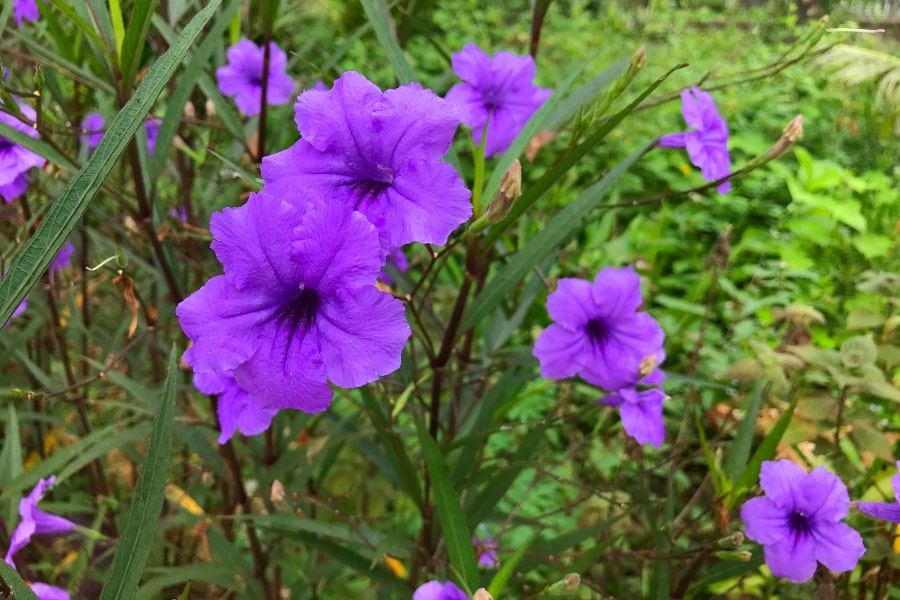
Pasque Flower
Pasque Flower has many names including Wind Flower, Windflower, Anemone Pulsatilla, Pulsatilla vulgaris. This early spring blooming flower works well in a moist, humic, shaded environment. We recommend planting under a tree in a leaf mulch area. This plant is poisonous when ingested, and the sap can also cause skin irritation so wear gloves if you are prone to rash. In 2024, we are growing the Red Bells variety, because no one else grows this plant and the flowers are quite stunning as they emerge in the early spring. This plant is an herbaceous perennial.
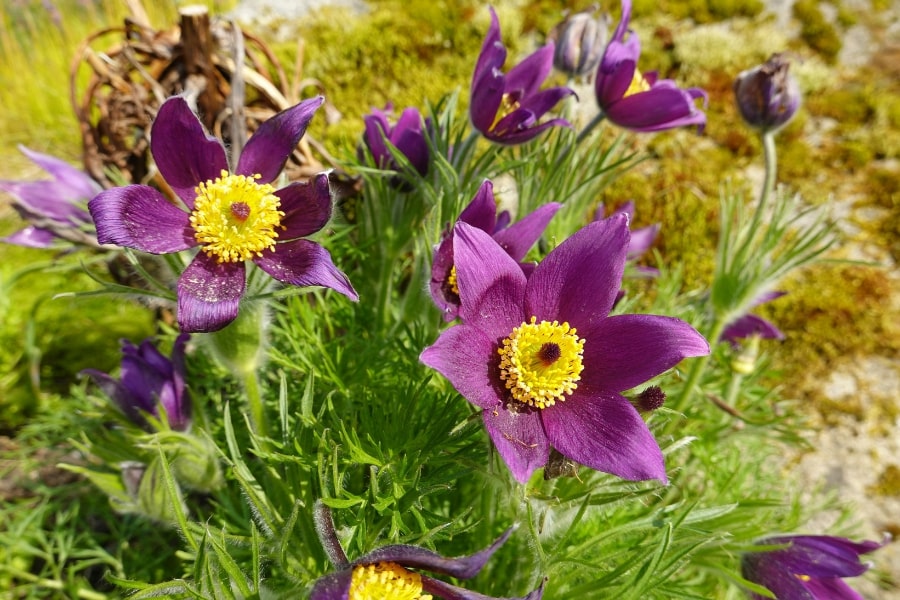
Peony
One of the best cut flowers around, peonies bloom in the early spring. With big bowls of petals and the perfect sweet scent. Bombs, full double and semi-double blooms are the most common we carry. We sell approximately 500 Peony in 2-gal and 3-gal containers. We also usually have an online tuber sale in February or March. Get on our mailing list to make sure you are notified. See our full list of offerings on our Peony page.
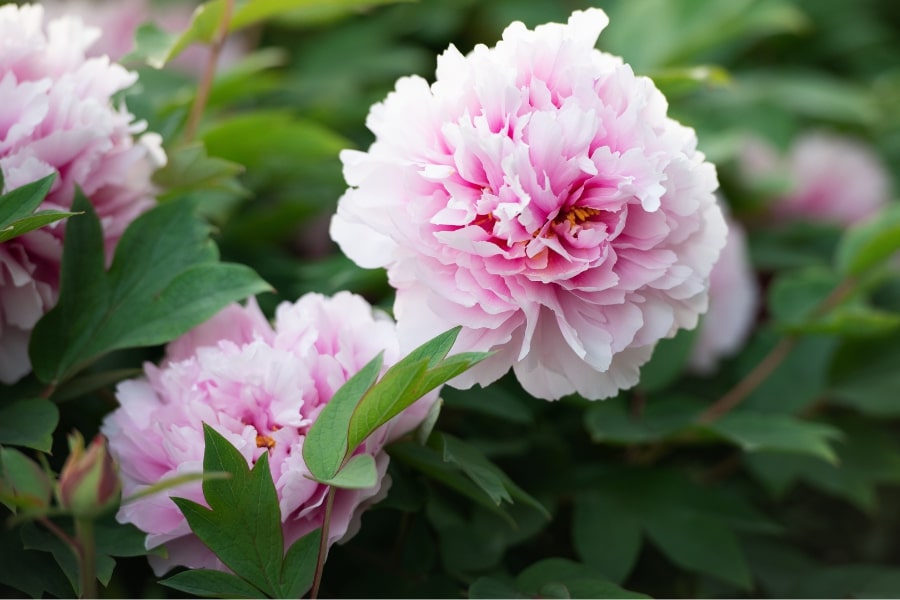
Obedient Plant
The Obedient Plant is a new plant for us in 2024, and it is a native … woohoo! We are growing the ‘Crystal Peak White’ hybrid and we will have a very limited quantity. The obedient plant got its name from its ability to be twisted into shape and to continue to retain the shape. They grow best in a part sun environment and like rich well drained soil. It flowers in late spring and sends up spires with blooms migrating from the bottom to the top. It boasts that it blooms all summer … we will see. It is attractive to bees and hummingbirds. Aphids tend to be an issue, so watch closely and treat with Bonide’s Insecticidal Soap. In the Upstate, this plant is an herbaceous perennial.
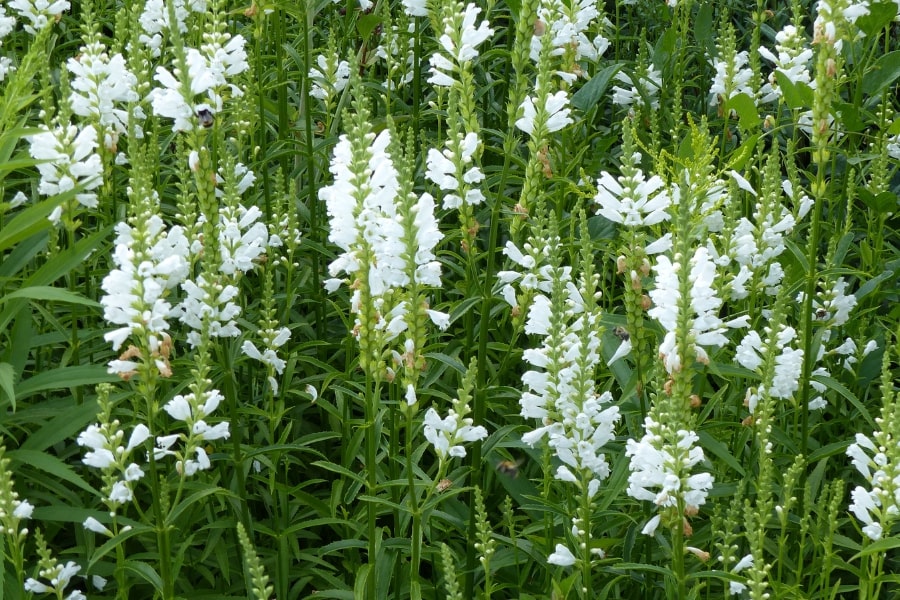
Polemonium (Jacobs Ladder)
We’ve tried before and we are trying again. The Jacob’s Ladder plant, commonly known as a Zone 7 plant, must be able to survive in Zone 8 in the shade, right? Or so we believe. We are currently growing the Stairway to Heaven variety because it is so freaking gorgeous, and in hopes that it will lead us to salvation … as a plant grower. In the meantime, wish us luck. And, buy it in late March when it becomes available or complain later. This is a shade plant folks, so don’t be fooled by any Northern tags. Furthermore, we advise that you water it like a Heuchera or watch it die of root rot. This plant is an herbaceous perennial in the Upstate.
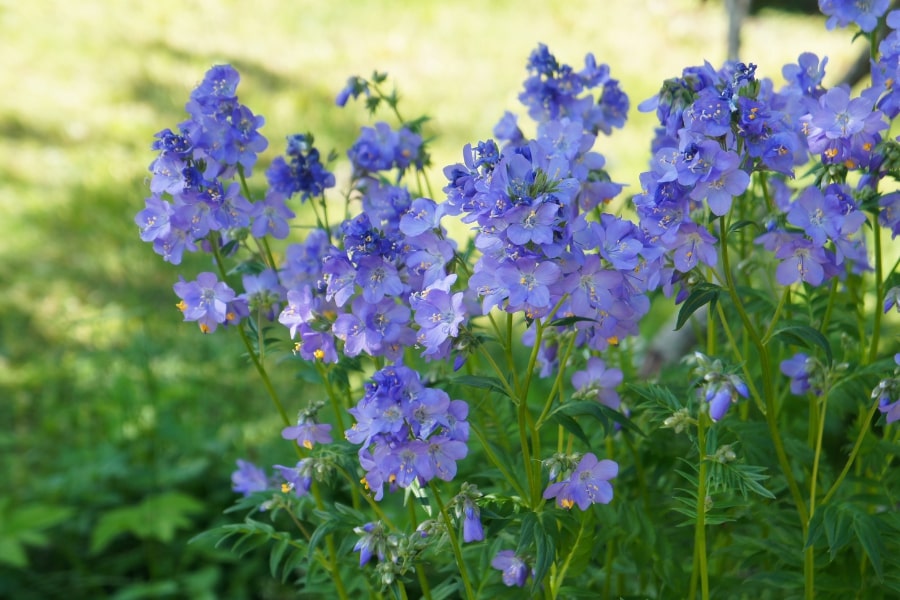
Potentilla (Cinquefoil)
We do not carry herbal Potentilla, only decorative. Please look for purchases via the internet for the herbal varieties. Occasionally and we mean occasionally, our vendors may have Potentilla. Unfortunately, as beautiful as it is, most customers looking for Potentilla are looking for the herbal varieties so consequently the variety we carry, Monarch’s Velvet, while beautiful, often becomes a disappointment for customers searching for herbal Potentilla. Monarch’s Velvet Potentilla is not a disappointment plant, nor should it ever be considered such. Buy our gorgeous Potentilla Monarch Velvet plant available mid-April, and enjoy their beautiful flowers that go all summer long … as long as you pinch the spent flowers regularly. Herbaceous perennial.
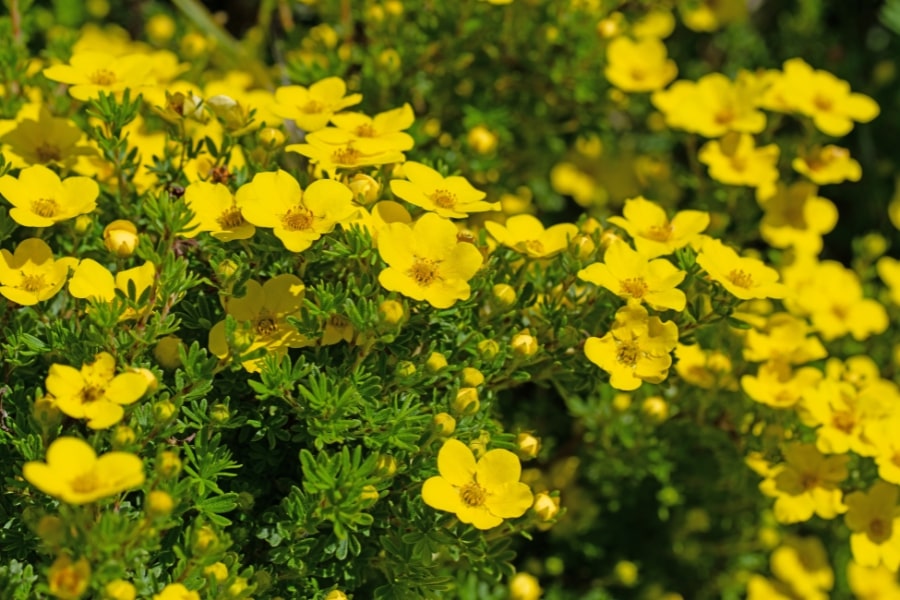
Senecio (Angel Wings)
Rarely, and we do mean rarely, do we see a game changer. Senecio Angel Wings is a game changer. Like Lambs Ears, but bigger and better. This full sun to full shade herbaceous perennial that sends out an amazing array of gray leaves that glow in the dark. They are soft and fuzzy. They grow rapidly. They are steadfast, low-growing gray groundcover for the rest of the season. They are a zone 8 tender perennial so mulch well in the winter.
Last year, we grew our first batch and sold out quickly. We will have ~125 6″ containers of these plants beginning early March and then another set beginning early April. We have no other vendors offering this plat for sale so get them while they’re available. This plant is an herbaceous perennial.
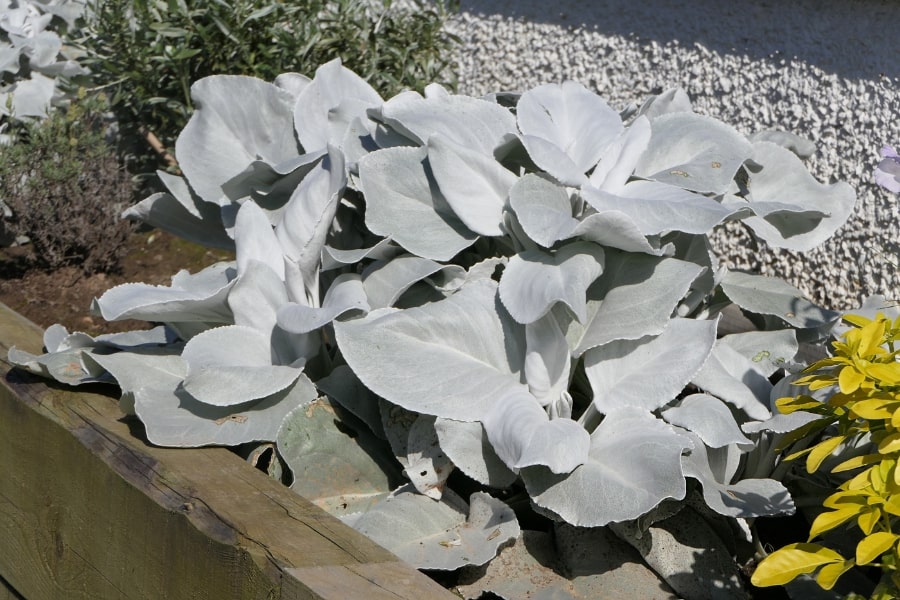
Soloman’s Seal (Polygonatum)
We carry at least one sometimes up to three different varieties of Soloman’s Seal in the spring, including the evergreen type, the variegated variety and the plain old non-hybrid green. With it’s delicate blooms off of arching foliage, it’s a must have for the background of a shade garden.
After it blooms out, the foliage is charming. It multiplies quickly by underground rhizomes in an organic-rich soil. If you plan on having it multiply, use some mushroom compost to amend your lovely clay soil before you plant. The non-hybrid green and the variegated types are herbaceous perennials.
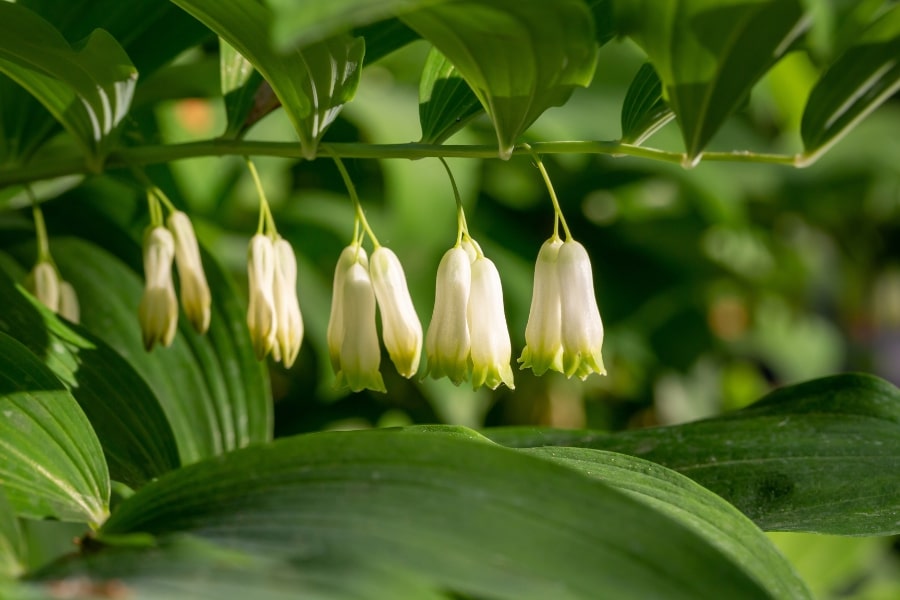
Eryngium (Thistle)
Globe thistle went from weed to desired plant over the last 10 years with the introduction of some gorgeous hybrids. And, it is no longer commonly known as thistle, it is now known as “Sea Holly.” It is an interesting transition, one that most old-time gardeners will laugh at because Globe Thistle was permitted to grow in meadows and around gardens because it acted as a bug attractor, particularly Aphids.
The first mistake we made when growing Eryngium was failing to understand the Aphid magnet issue. The second mistake we made was the very difficult relationship between underwatering and overwatering. The third mistake we made was failing to realize that Eryngium is a biennial and does not flower until its second year and no one wants a non-flowering plant. Ugh.
Lessons now learned, we still plan to offer Eryngium because it is truly stunning while in bloom and makes a great cut flower. We also believe it has a place in all gardens as an Aphid attractor to protect your other plants. Unfortunately, due to space limitations, this year, we are reliant on our vendors to provide us 2-year old blooming Eryngium, which is an herbaceous sun perennial. We wish you luck … we’ll let you know through our social media if we score any “Sea Holly.”
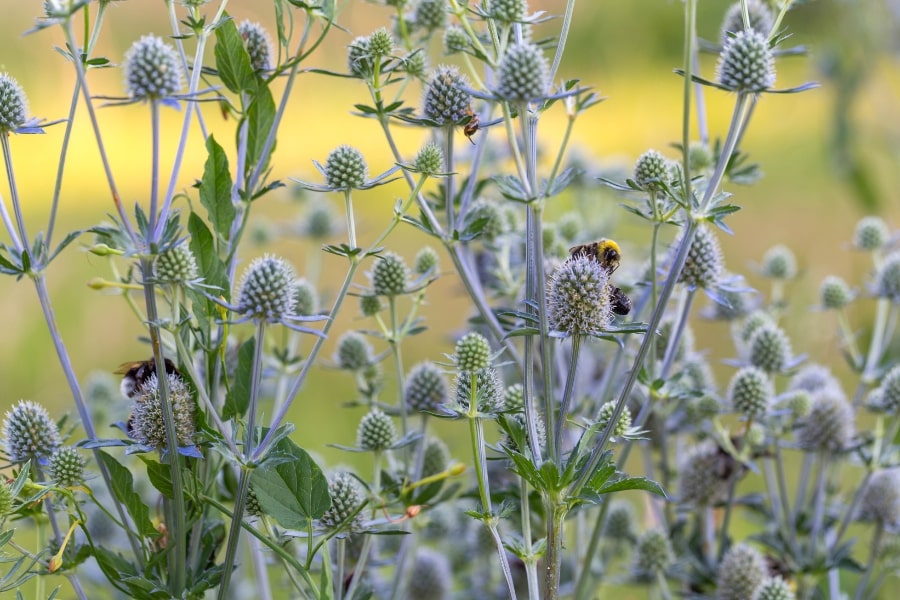
Tiarella (Foam Flower)
So remember your old friend Huechera … well flashforward to Tiarella, which is similar but different. This clumping evergreen perennial is a native and is a shade lover. It flowers more profusely than Heuchera with spires of white and sometimes blush pink blooms in the Spring. It has been successfully crossed with Heuchera to produce Heucherella plants such as the beloved Buttered Rum Heucherella.
It spreads more easily than Heuchera but does not tolerate drought. Still, similar to Heuchera, it should be planted in a well-drained soil and not overwatered. We are currently growing several Tiarella varieties including Sugar and Spice and Candy Striper so as to test the market. The first crops should be available early March and the second crop will be available mid- to late-April.
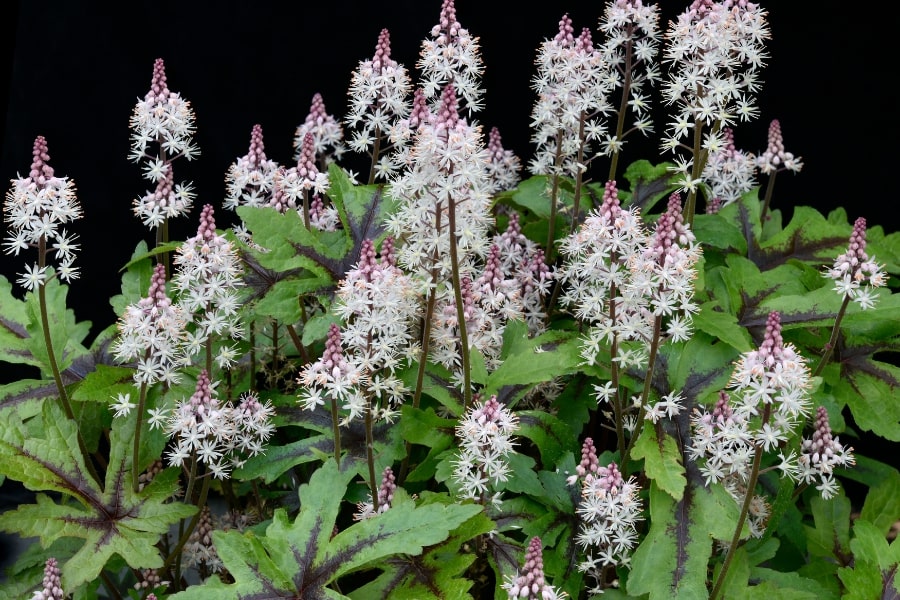
Tricyrtis (Toad Lily)
Toad Lily’s come and go at Martin Garden Center, and they are quite a collector’s item due to their uniquely colored, bizarrely shaped, and always spotted flowers. In the 2024 year, we are growing the Gilt Edge Toad Lily (available mid-March) and Mrs. Moon and Sissingham White (available late-April). We will also bring in groups from our vendors. We sell about 50+ each year. These are available sporadically, so watch our social media for notifications. Toad Lily’s are an herbaceous, part-sun to shade perennial in the Upstate.
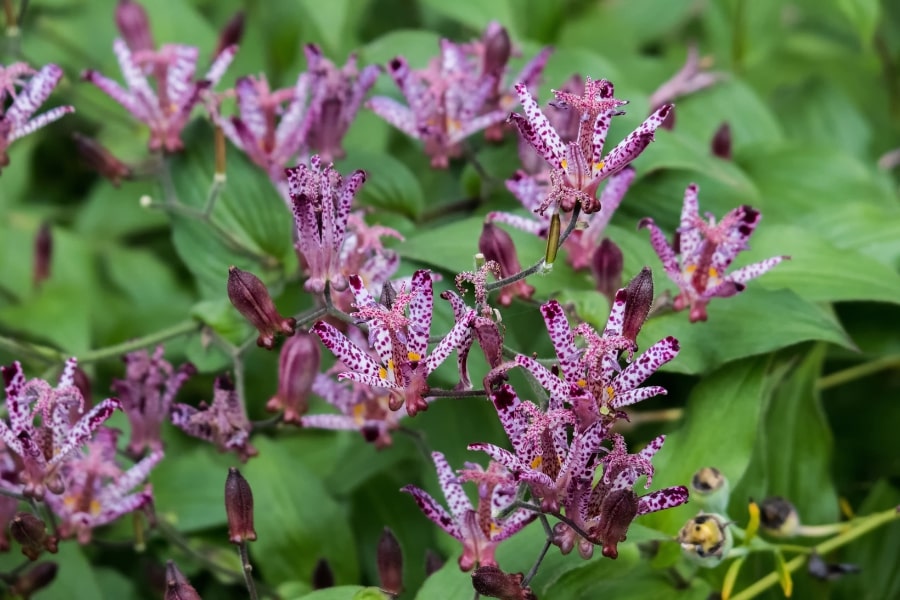
Tradescantia (Spiderwort)
By far the most popular of the Spiderworts is Sweet Kate. This chartreuse beauty is a spring must have, as it erupts into thick grasslike chartreuse foliage and then blossoms in flowers of opposite colored purple. Concord Grape is also a commonly found Spiderwort and it is attractive with its dark green foliage … but not stunning like Sweet Kate. We try to carry Sweet Kate when available in the early spring but it is not commonly found so we may sell 25 -50 each year.
By summer, we are sold out which is probably for the best because Sweet Kate begins to look a little less attractive as the season goes on … just being honest. This plant is less commonly referred to as a Spider Lily, which is very unfortunate because Tradescantia is not a Spider Lily. Spiderwort can work in part or full sun, and is a semi-evergreen perennial in the Upstate.
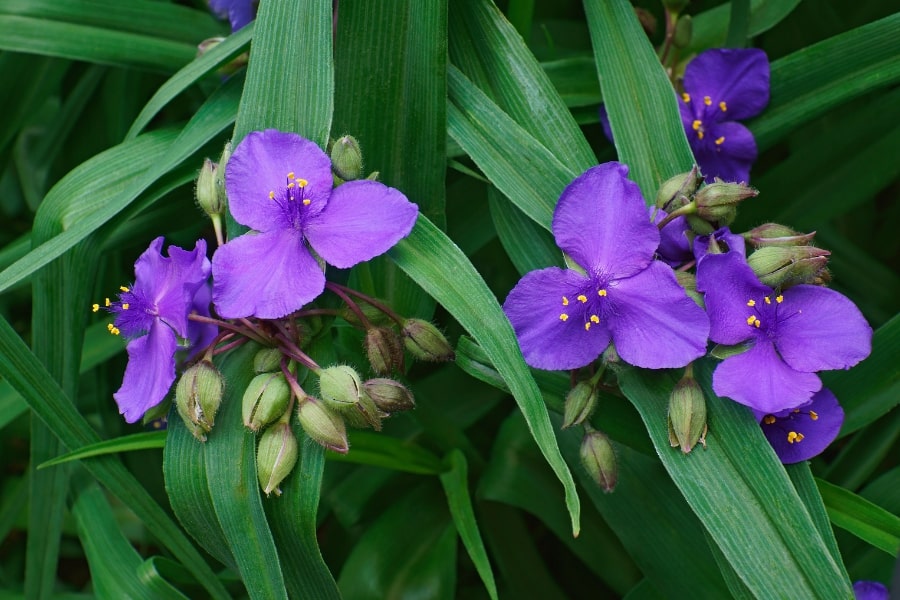
Spigelia (Indian Pink)
This herbaceous beauty is best grown in part sun to shade in the Upstate. Indian Pink is so amazing and so Red, not Pink. We try and try to get it in, but it is a hit and miss when we try to get this plant. It is indigenous and a wildflower and we have found it growing wild in forests in Mississippi. It is considered a threatened species (Spigellia miralandica) in the State of North Carolina.
In 2024, we found the Little Redhead hybrid starts available from one of our vendors … Hurray … but it will sell out quickly once it is available circa late March.
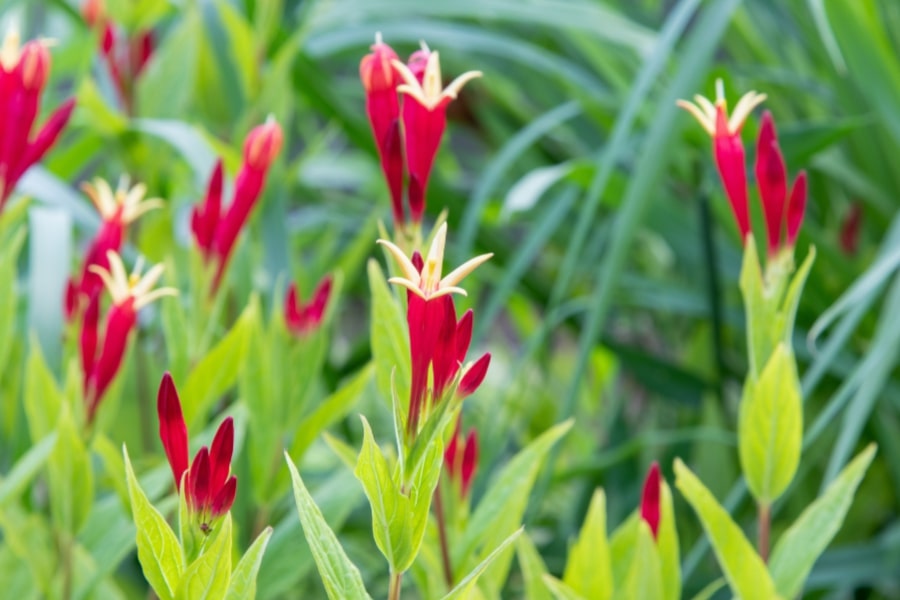
Verbascum (Mullein)
Verbascum is a full-sun herbaceous perennial in the Upstate. This plant’s beauty caught us by surprise. We have, for 3 years now, brought in the hybrids Dark Eyes and Plum Smokey and they are stunning. This full-sun plant sets a taproot so once planted don’t move it. It also likes well-drained soil so don’t overwater it.
Once the main stalks spike has bloomed mostly out, remove it to extend the bloom time for the secondary stalks. The show goes on for a long time. And the soft lambs-ear like leaves only adds to the beauty of this plant. These plants begin blooming in the Upstate in April, and rarely reach full bloom before they are sold out for the season.
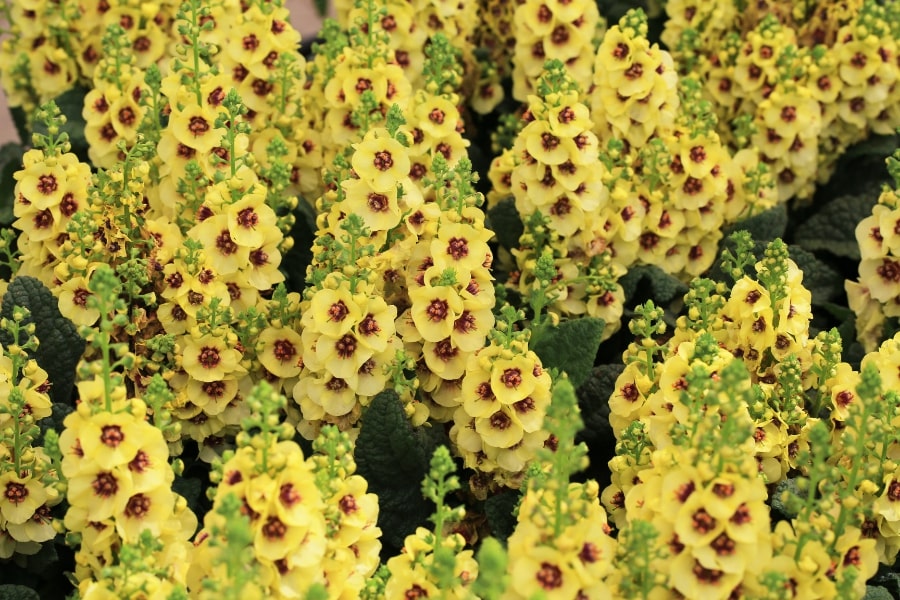
Vernonia (Iron Weed)
Vernonia is a herbaceous perennial. Customers should buy this plant just for the name Iron Weed. Add in that this is a native wildflower and won the 2004 North Carolina Wildflower of the Year, and we all get chills. In 2024, we are offering the Iron Butterfly variety in 6″ containers. This plant loves the sun and is very drought tolerant.
The Iron Butterfly variety only gets 2-3 feet, and the spiny dark green foliage makes a perfect backdrop for other plants until blooming late-summer. Remember, this is a butterfly nectar source when all other summer bloomers are failing. Watch for it to be available in late-April and then sold out till next year. Love me some Iron Weed!
